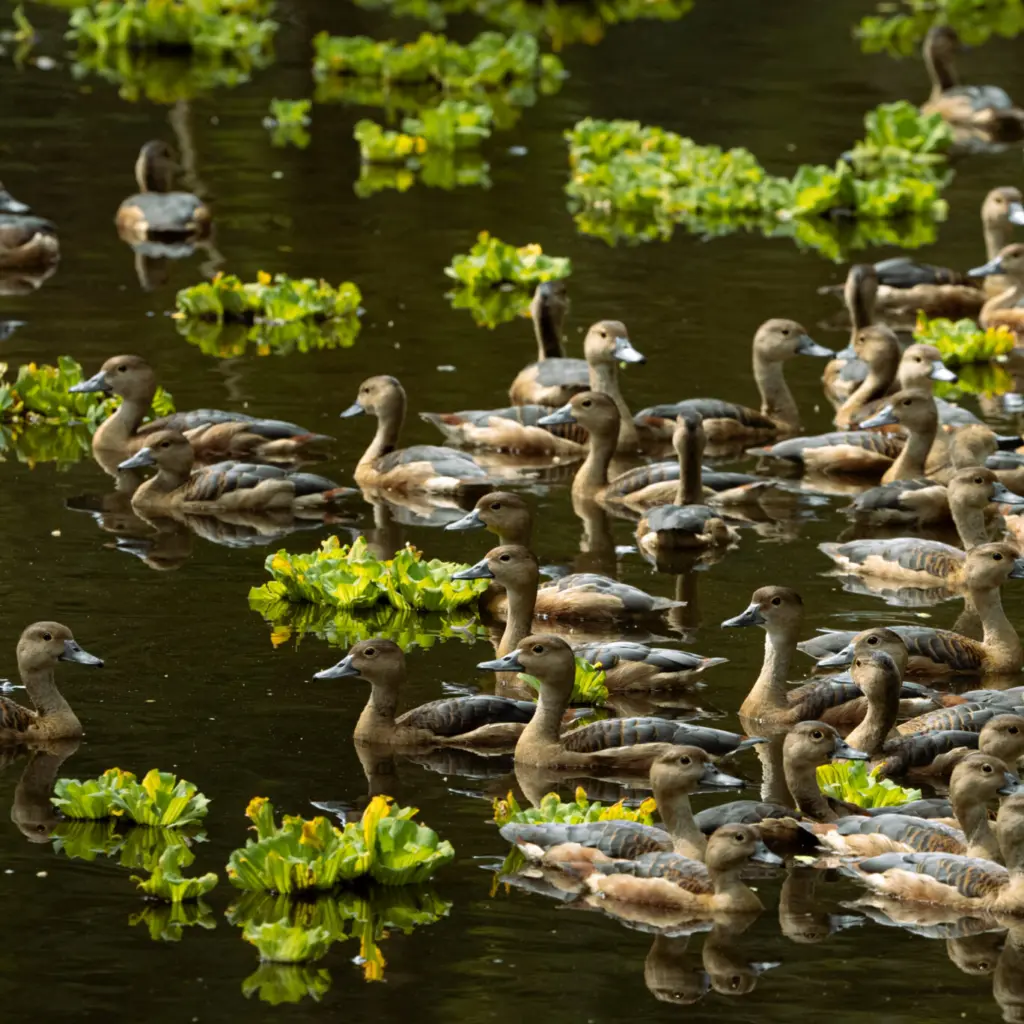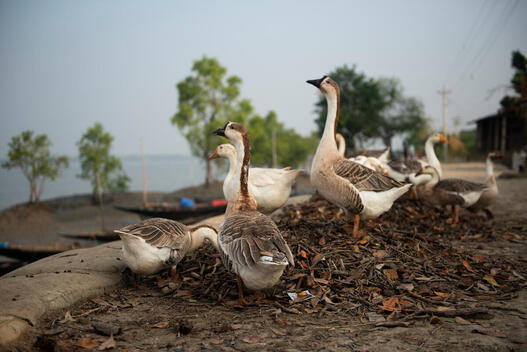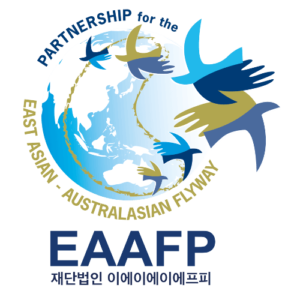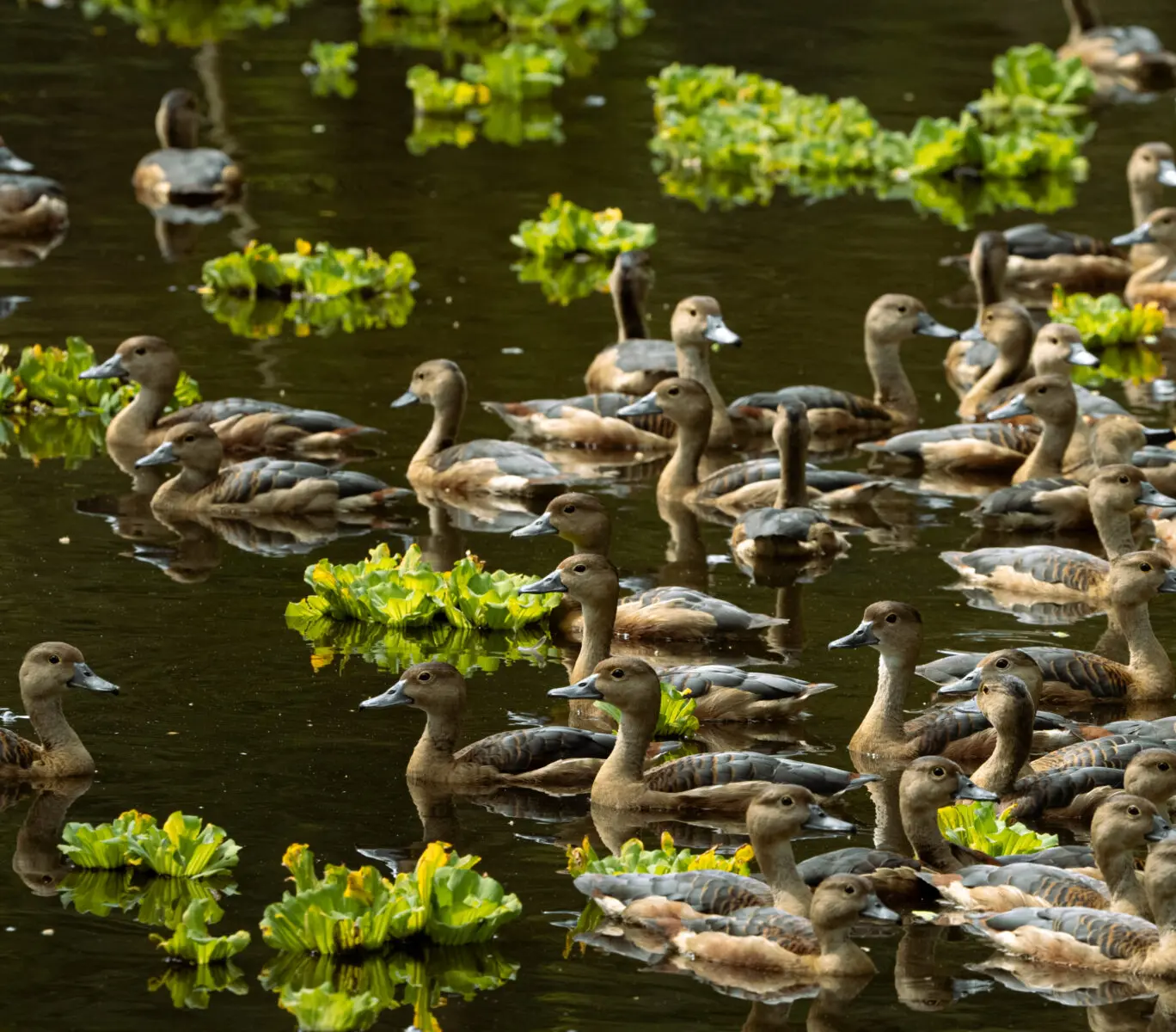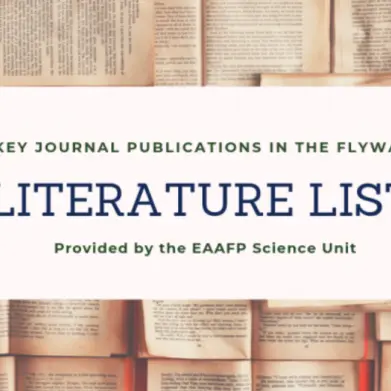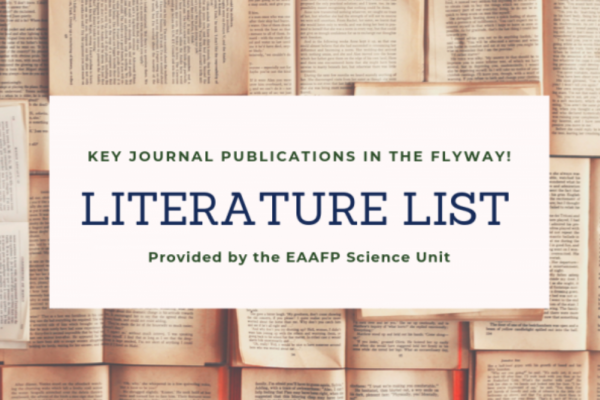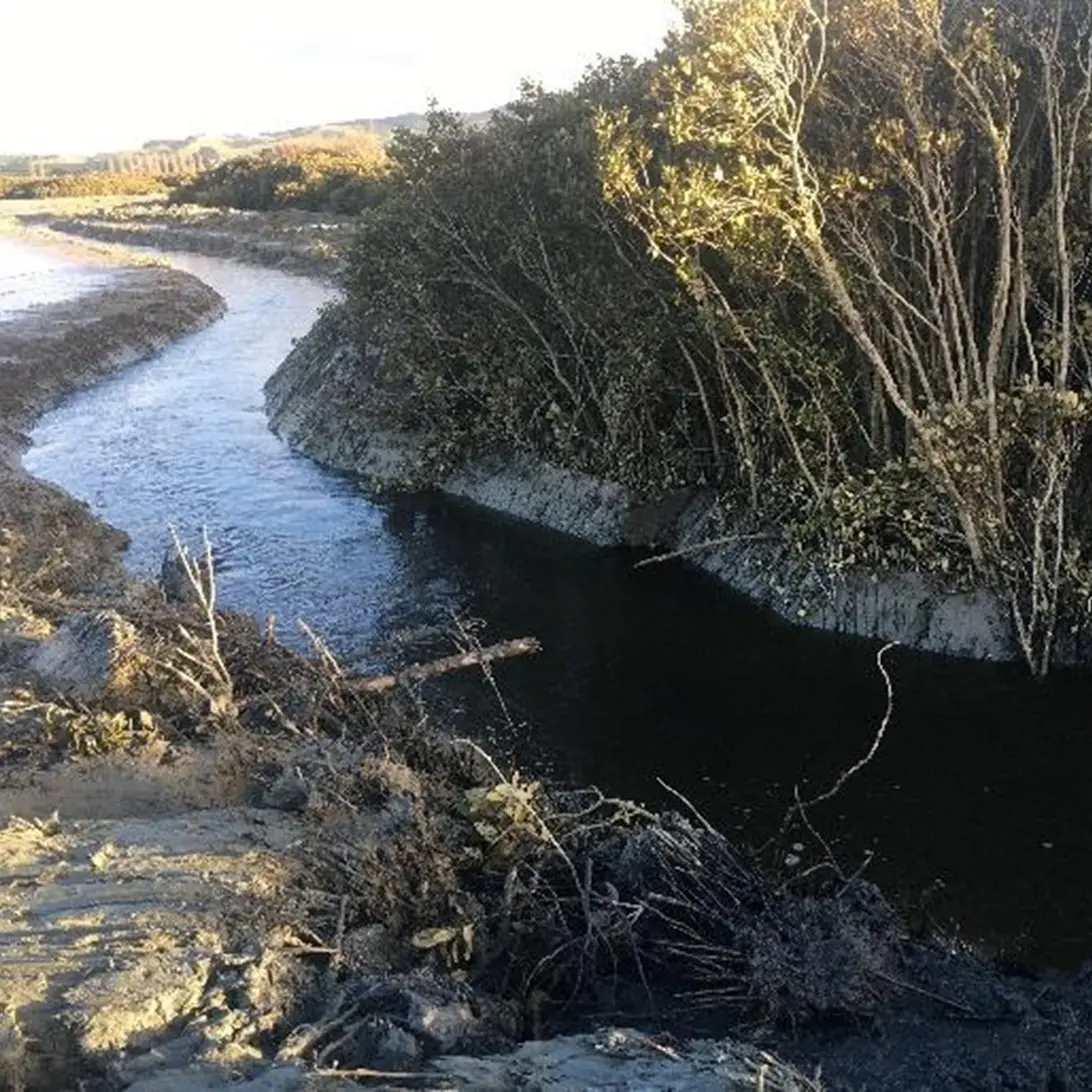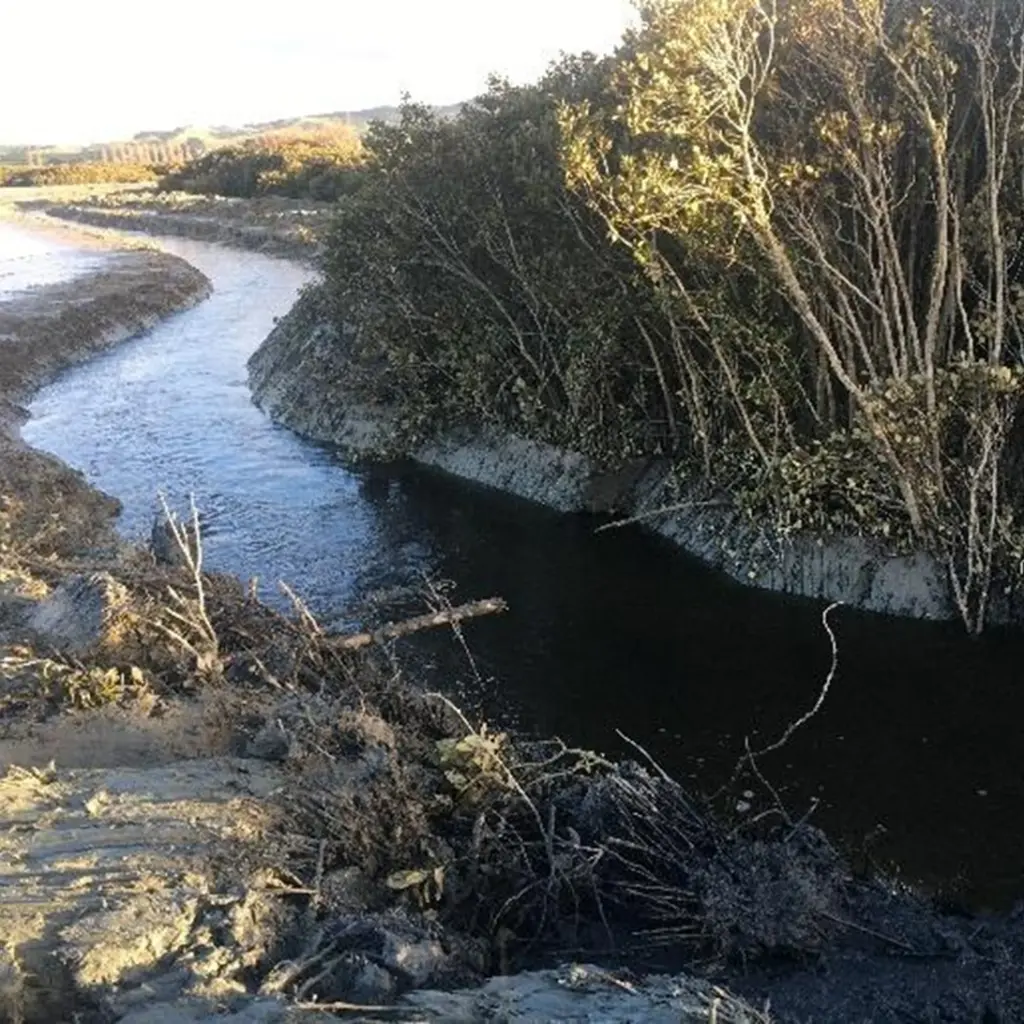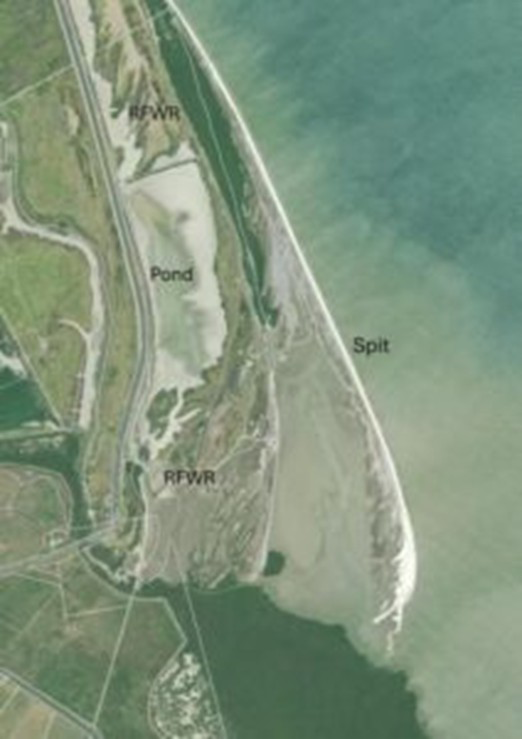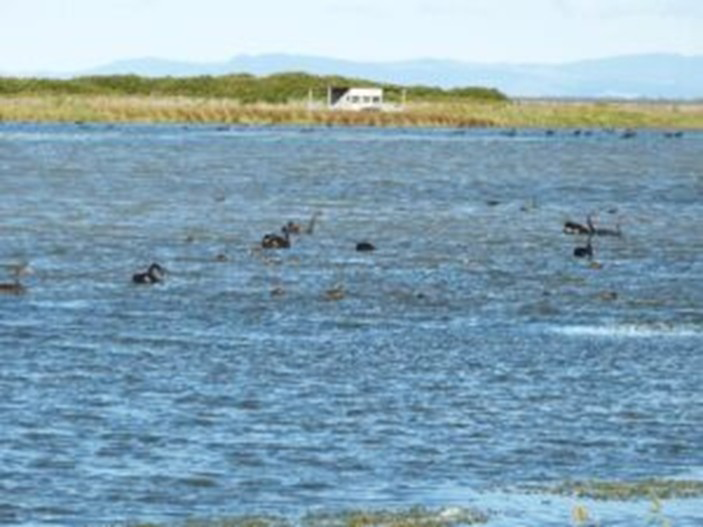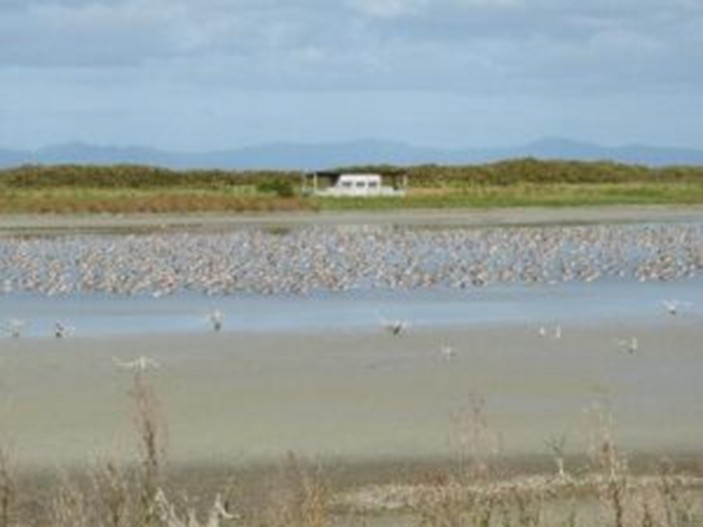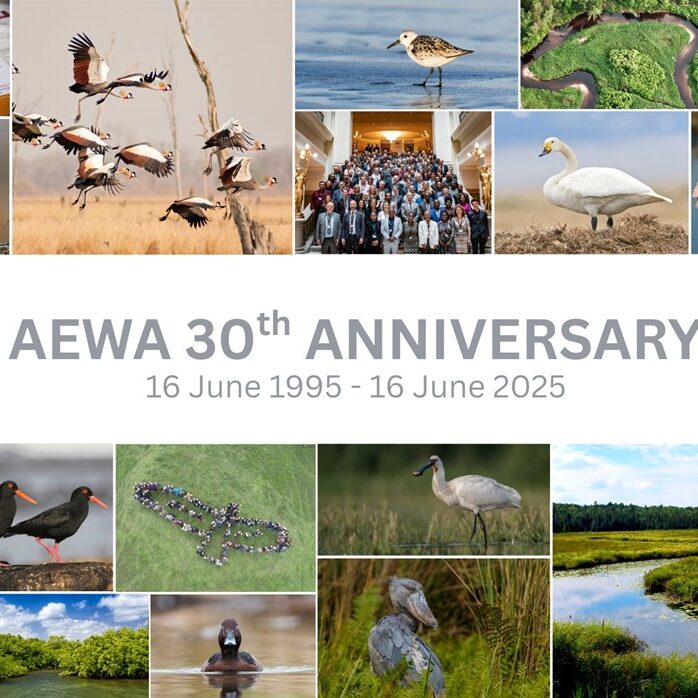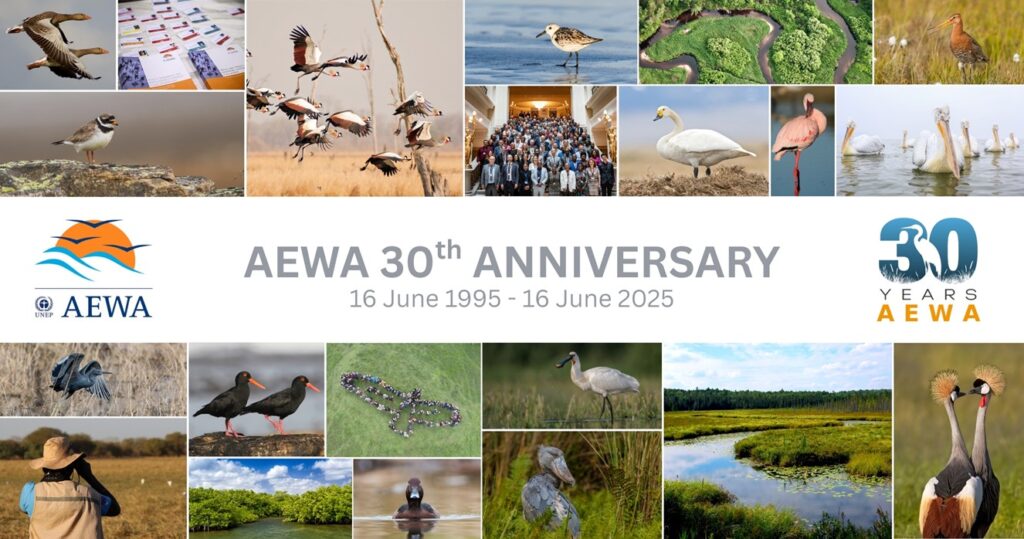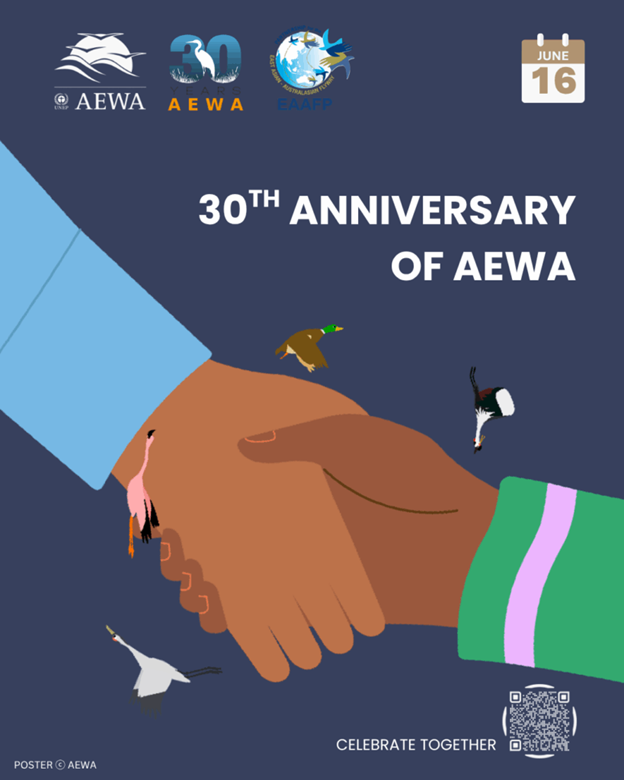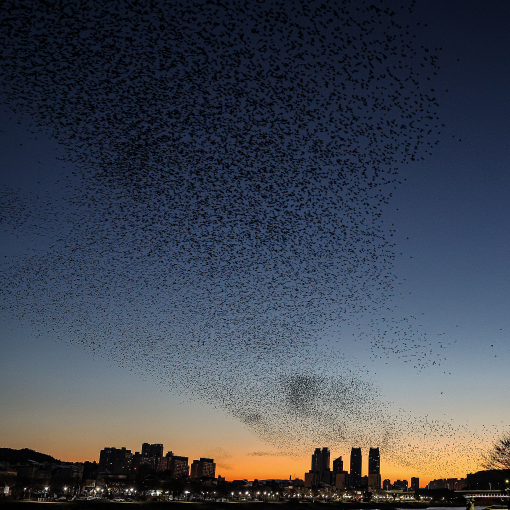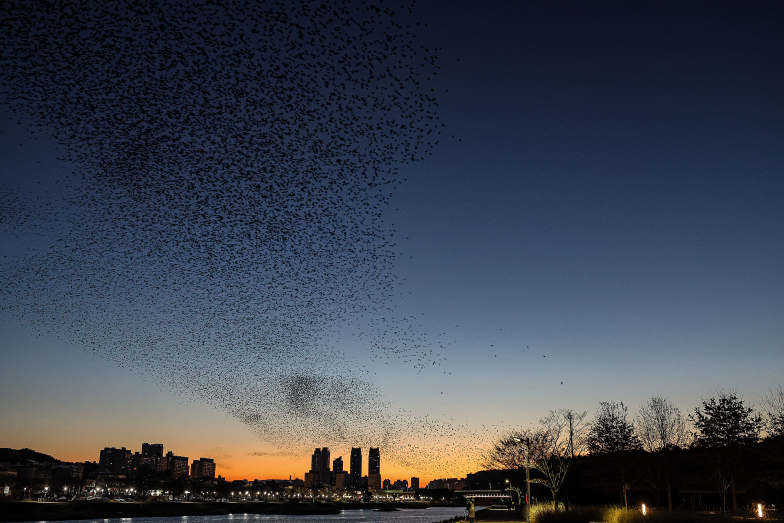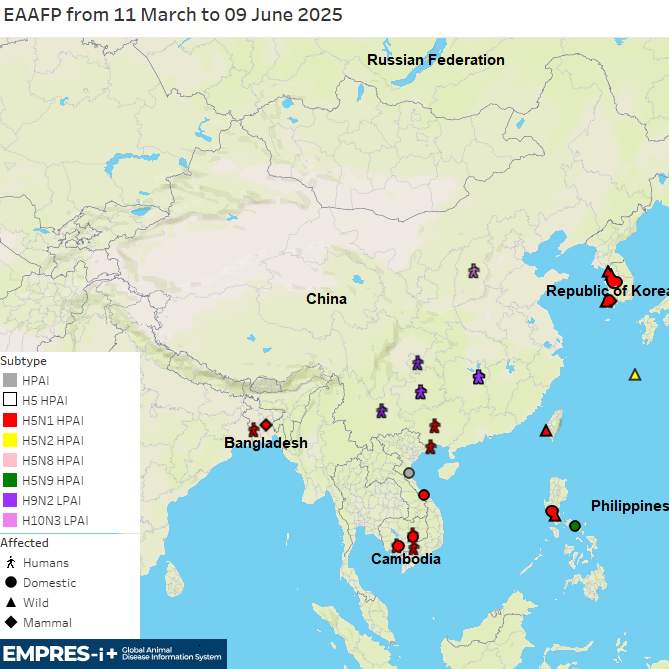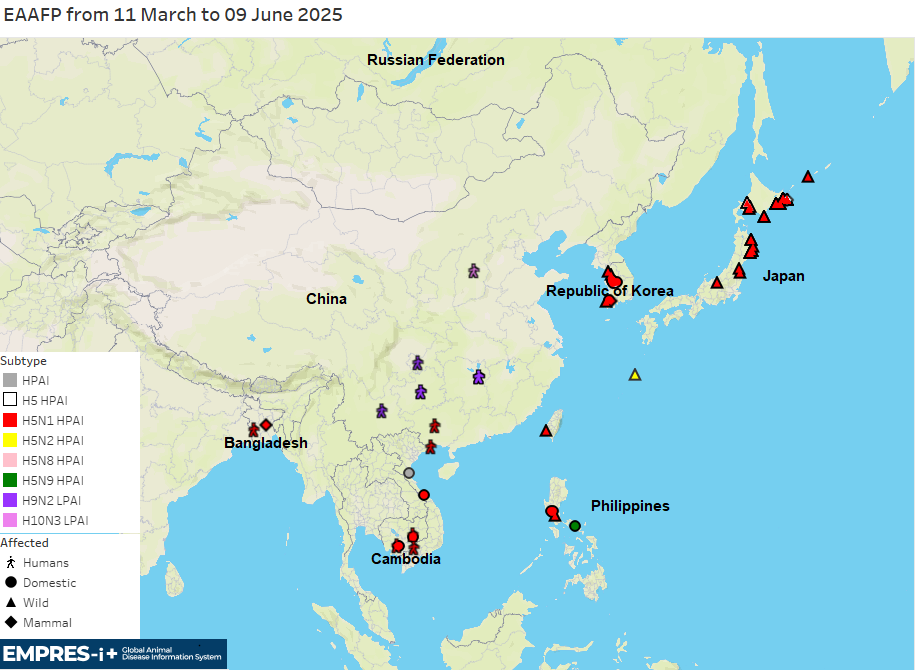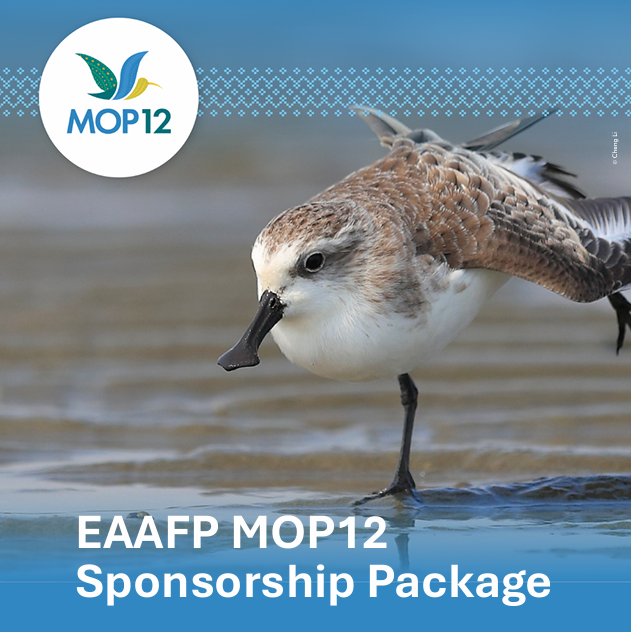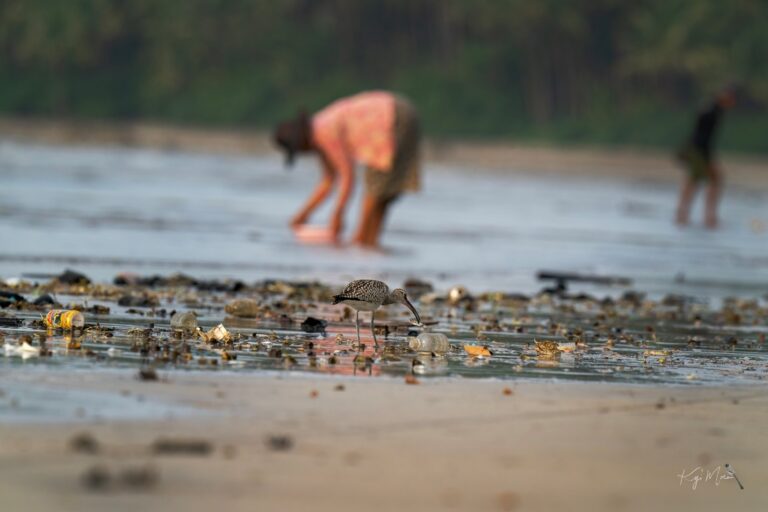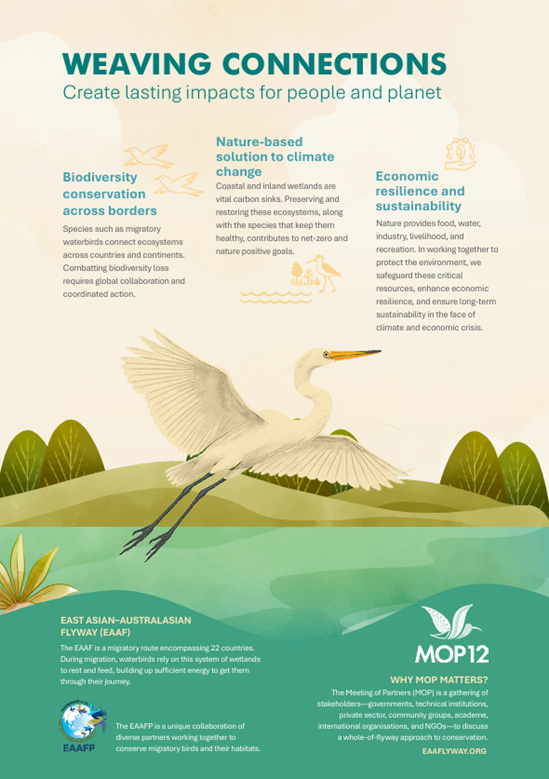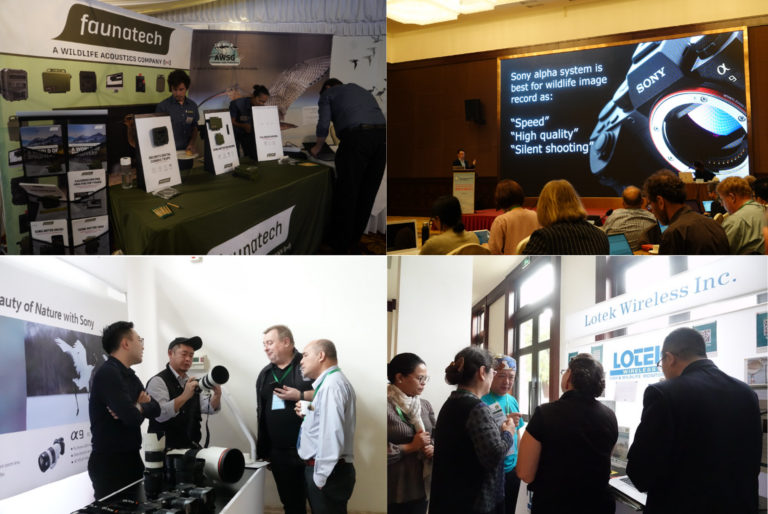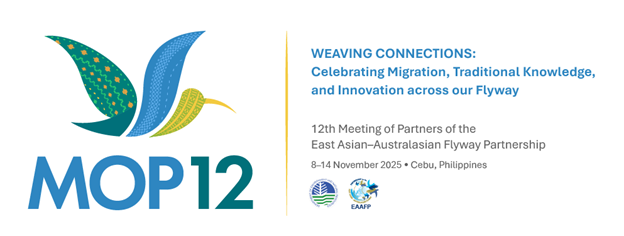1) 생물학 & 생태학
- WEI J, XU F, COLE E F, et al., 2024. Spatially heterogeneous shifts in vegetation phenology induced by climate change threaten the integrity of the avian migration network[J/OL]. Global Change Biology, 30(1): e17148. DOI:10.1111/gcb.17148.
- CHENXI W, SHAOXIA X, XIUBO Y, et al., 2024. It takes two to Tango: Plant height and nutrient level determine the diet selection of wintering geese in Poyang Lake, a Ramsar wetland[J/OL].Global Ecology and Conservation, 49: e02802.DOI:10.1016/j.gecco.2024.e02802.
- ROSS T A, ZHANG J, CHIANG C Y, et al., 2024. Running the gauntlet; flyway-wide patterns of pollutant exposure in blood of migratory shorebirds[J/OL]. Environmental Research, 246: 118123. DOI:10.1016/j.envres.2024.118123.
- EMROSE A, SHOME A R, ALAM Md M, et al., 2024. Northwestern transboundary area of Bangladesh: a key to sustaining a quarter of the country’s avian species[J/OL]. Ornithology Research, 32(1): 23-32. DOI:10.1007/s43388-023-00163-z.
- ROMANOV A A, 2024. Ecological and Geographical Structure and Dynamics of Spring Migration of Water and Semiaquatic Birds on the Putorana Plateau[J/OL]. Contemporary Problems of Ecology, 17(1): 1-14. DOI:10.1134/S1995425524010116.
- ZHENG Y, Wu ,Junhong, Sheviakina ,Natalia, et al., 2024. Using remote-sensing data to study the rapid growth of wind farms and their impact on bird habitat in Yellow Sea Wetland, China[J/OL]. Remote Sensing Letters, 15(3): 245-257. DOI:10.1080/2150704X.2024.2318758.
- VAN BEMMELEN R S A, MOE B, SCHEKKERMAN H, et al., 2024. Synchronous timing of return to breeding sites in a long-distance migratory seabird with ocean-scale variation in migration schedules[J/OL]. Movement Ecology, 12(1): 22. DOI:10.1186/s40462-024-00459-9.
- WANG L, GONG Y, 2024. Area- and latitude- shaped shorebird diversity patterns reveal constraints of migratory bottlenecks along the Yellow sea coast of China[J/OL]. Ecological Indicators, 160: 111924. DOI:10.1016/j.ecolind.2024.111924.
- PENG H B, CHAN Y C, HUANG Y, et al., 2024. Intraseasonal movements between staging sites by migrating great knots: Longer distances to alternatives decrease the probability of such moves[J/OL]. Biological Conservation, 292: 110547. DOI:10.1016/j.biocon.2024.110547.
- CUI L, WEI Z, ZHOU L, et al., 2024. Effects of constant high water levels in winter on waterbird diversity in Caizi Lakes: A functional perspective[J/OL]. Global Ecology and Conservation, 52: e02934. DOI:10.1016/j.gecco.2024.e02934.
- KIM E J, HUR W H, KIM H J, et al., 2024. Population trend and spatio-temporal distribution of Greater White-fronted (Anser albifrons) and Bean Geese (Anser fabalis) in Korea[J/OL]. Avian Research, 15: 100214. DOI:10.1016/j.avrs.2024.100214.
- SABANO Y, SAWA Y, UEMURA S, et al., 2024. Population trends and distribution of the Lesser Snow Goose Anser caerulescens caerulescens in Japan, based on 50 years of monitoring[J]. Wildfowl(0): 69.
- AN S, KUANG F, WU W, et al., 2024. Individual consistency in spatiotemporal characteristics of migratory Whimbrels in the East Asian-Australasian Flyway[J/OL]. AVIAN RESEARCH, 15: 100191. DOI:10.1016/j.avrs.2024.100191.
- DOROFEEV D, IVANOV A, KHUDYAKOVA E, et al., 2024. Biometric variability and sexual size dimorphism in the Great Knot Calidris tenuirostris[J/OL]. EUROPEAN ZOOLOGICAL JOURNAL, 91(1): 64-74. DOI:10.1080/24750263.2023.2293120.
- TOMITA N, SATO F, THIEBOT J B, et al., 2024. Incomplete isolation in the nonbreeding areas of two genetically separated but sympatric short-tailed albatross populations[J/OL]. ENDANGERED SPECIES RESEARCH, 53: 213-225. DOI:10.3354/esr01302.
- SULTANA I, KHANDAKAR N, DAS D K, et al., 2024. Polychaete worm density correlates with aggregate shorebird density, prey intake rate and foraging success at an intertidal mudflat in Bangladesh[J/OL]. ARDEA, 112(1). DOI:10.5253/arde.2023.a10.
- QAYUM S, KALHORO M A, HAKEEM A, et al., 2024. Population Monitoring and Major Threats to Demoiselle Crane (grus Virgo) at Lasbela Coast, Balochistan, Pakistan[J/OL]. JOURNAL OF ANIMAL AND PLANT SCIENCES-JAPS, 34(1): 145-156. DOI:10.36899/JAPS.2024.1.0703.
- SON S J, DO M S, CHOI G, et al., 2024. Identifying research trends in avian migration tracking in Korea using text mining[J/OL]. JOURNAL OF ASIA-PACIFIC BIODIVERSITY, 17(2): 303-308. DOI:10.1016/j.japb.2023.12.001.
- LEE M B, LEE J H, BING G C, et al., 2024. Spatiotemporal variations in migratory bird diversity and abundance along the coast of Gochang getbol[J/OL]. PLoS ONE, 19(5): e0300353. DOI:10.1371/journal.pone.0300353.
2) 보전 & 관리
- JACKSON M V, MOTT R, DELEAN S, et al., 2024. Shorebird habitat selection and foraging behaviour have important implications for management at an internationally important non-breeding wetland[J/OL]. Ecological Solutions and Evidence, 5(1): e12316. DOI:10.1002/2688-8319.12316.
- XU P, MAO S, ZHANG S, et al., 2024. Habitat utilization of the Eurasian spoonbill (Platalea leucorodia) wintering in the Yancheng National Nature Reserve: relative importance of artificial habitats[J/OL]. Frontiers in Ecology and Evolution, 12[2025-05-21]. https://www.frontiersin.org/journals/ecology-and-evolution/articles/10.3389/fevo.2024.1357765/full. DOI:10.3389/fevo.2024.1357765.
- XIE Y, ZOU J, CHEN Y, et al, 2024. Are wading birds the ideal focal species for broader bird conservation? A cost-effective approach to ecological network planning[J/OL]. Ecological Indicators, 160: 111785. DOI:10.1016/j.ecolind.2024.111785.
- WANG C, XIA S, DUAN H, et al., 2024. Study on the impact of reclamation and development of Yancheng coastal wetlands on the spatio-temporal evolution of wintering Anatidae habitat[J/OL]. Ecological Indicators, 160: 111892. DOI:10.1016/j.ecolind.2024.111892.
- ABULFAZ T, NATAVAN K, 2024. The influence of the decrease in the water level in the Caspian Sea on certain species within the Gulls (Laridae) family[J]. JOURNAL OF WILDLIFE AND BIODIVERSITY, 8(2).
- BERRYMAN A J, BUTCHART S H M, JACKSON M V, et al., 2024. Trends and patterns in the extinction risk of Australia’s birds over three decades[J/OL]. EMU-AUSTRAL ORNITHOLOGY, 124(1): 55-67. DOI:10.1080/01584197.2023.2289999.
- SHI J, MENG L, XIA S, et al., 2024. Habitat Suitability and Determinants for Anatidae in Multi-Watershed Composite Wetlands in Anhui, China[J/OL]. ANIMALS, 14(7): 1010. DOI:10.3390/ani14071010.
- XIA S, XUE Z, DONG S, et al., 2024. Identification and scoring of conservation gaps in wetlands of China’s coastal provinces: Implications for extending protected areas[J/OL]. JOURNAL OF ENVIRONMENTAL MANAGEMENT, 358: 120865. DOI:10.1016/j.jenvman.2024.120865.
- LISOVSKI S, HOYE B J, CONKLIN J R, et al., 2024. Predicting resilience of migratory birds to environmental change[J/OL]. PROCEEDINGS OF THE NATIONAL ACADEMY OF SCIENCES OF THE UNITED STATES OF AMERICA, 121(19): e2311146121. DOI:10.1073/pnas.2311146121.
- GALLO-CAJIAO E, MORRISON T H, FULLER R A, 2024. Agreements for conserving migratory shorebirds in the Asia-Pacific are better fit for addressing habitat loss than hunting[J/OL]. AMBIO, 53(9): 1336-1354. DOI:10.1007/s13280-024-02018-3.
- XU L, SUN Q, STORCH I, et al., 2024. Assessing habitat suitability and conservation priorities for flagship crane species across critical wetlands in northeast China[J/OL]. BIOLOGICAL CONSERVATION, 294: 110638. DOI:10.1016/j.biocon.2024.110638.
- GOMBOBAATAR S, USUSKHJARGAL D, YOSEF R, 2024. A Review of the Conservation Status of Shorebirds in Mongolia[J/OL]. ANIMALS, 14(12): 1752. DOI:10.3390/ani14121752.
- CHEN W J, CHANG A Y, LIN C C, et al., 2024. Losing Tidal Flats at the Midpoint of the East Asian-Australasian Flyway over the past 100 Years[J/OL]. WETLANDS, 44(5): 59. DOI:10.1007/s13157-024-01814-7.
- LUAN B, LIU Y, ZHOU W, et al., 2024. Exploring Nature-based Solutions on Refined Waterbird Habitats Restoration in High-density Urban Area: A Case Study of the Futian Mangrove National Important Wetland in Shenzhen, China[J/OL]. Landscape Architecture Frontiers, 12(3): 36. DOI:10.15302/J-LAF-0-020018.
- XIA S, LV H, DUAN H, et al., 2024. Deteriorating habitat suitability and connectivity of waterbirds in the Bohai Sea Rim: Consequences of land use transformation[J/OL]. GLOBAL ECOLOGY AND CONSERVATION, 51: e02930. DOI:10.1016/j.gecco.2024.e02930.
3) 조류 인플루엔자/그 외
- ÇELIK Ş K, BAL S Ş, 2024. An Evaluation of Radon Concentrations in Arin Lake, Bitlis[J/OL]. Water, Air, & Soil Pollution, 235(2): 94. DOI:10.1007/s11270-024-06903-1.
- CAO X, ZHENG X, BAI F, et al., 2024. Pollutant Exposure for Chinese Wetland Birds: Ecotoxicological Endpoints and Biovectors[J/OL]. ACS ES&T Water, 4(5): 2076-2087. DOI:10.1021/acsestwater.3c00707.
- WANG Y, ZHAN H, SAIF A, et al, 2024. Analysis of winter survival strategies of sympatric black-necked cranes, and common cranes from the perspective of diet and gut microbiota[J/OL]. Ecological Indicators, 160: 111782. DOI:10.1016/j.ecolind.2024.111782.
- LEE Y J, PARK J Y, SHANG K, et al., 2024. Genetic Characterization of Avian Paramyxovirus Isolated from Wild Waterfowl in Korea between 2015 and 2021[J/OL]. Animals, 14(5): 780. DOI:10.3390/ani14050780.
- LI Z, DUAN T, WANG L, et al., 2024. Comparative analysis of the gut bacteria and fungi in migratory demoiselle cranes (Grus virgo) and common cranes (Grus grus) in the Yellow River Wetland, China[J/OL]. Frontiers in Microbiology, 15[2025-05-21]. https://www.frontiersin.org/journals/microbiology/articles/10.3389/fmicb.2024.1341512/full. DOI:10.3389/fmicb.2024.1341512.
- LV X, ZHAO Q, FEI M, et al., 2024. First observations in 20 years of Brent Geese Branta bernicla wintering on the Shandong coast, China[J]. WILDFOWL, 74: 84-98.
- BOE C A, FISKEBECK E M L Z, REITEN M R, et al., 2024. Emergence of highly pathogenic avian influenza viruses H5N1 and H5N5 in white- tailed eagles, 2021-2023[J/OL]. JOURNAL OF GENERAL VIROLOGY, 105(11): 002035. DOI:10.1099/jgv.0.002035.
- LIU G, XU N, YU C, 2024. Comparative analysis of the microbiome of sympatric wintering Bean Geese, Domestic Ducks, humans, and soil at Shengjin Lake of China reveals potential public risk to human health[J/OL]. AVIAN RESEARCH, 15: 100175. DOI:10.1016/j.avrs.2024.100175.
- LI T, ZHAO C, GUO Y, et al., 2024. Genetic and Biological Characteristics of Duck-Origin H4N6 Avian Influenza Virus Isolated in China in 2022[J/OL]. VIRUSES-BASEL, 16(2): 207. DOI:10.3390/v16020207.
- GLAZUNOVA A, KRASNOVA E, BESPALOVA T, et al., 2024. A highly pathogenic avian influenza virus H5N1 clade 2.3.4.4 detected in Samara Oblast, Russian Federation[J/OL]. FRONTIERS IN VETERINARY SCIENCE, 11: 1244430. DOI:10.3389/fvets.2024.1244430.
- KIM T H, CHO A Y, LEE S H, et al., 2024. Isolation and whole genome sequencing of North American lineage class I avian orthoavulavirus 1 isolated from wild Eurasian teal in South Korea[J/OL]. AVIAN PATHOLOGY, 53(3): 194-198. DOI:10.1080/03079457.2024.2312116.
- LI Y, AN Q, SUN Z, et al., 2024. Multifaceted analysis of temporal and spatial distribution and risk factors of global poultry HPAI-H5N1, 2005-2023[J/OL]. ANIMAL, 18(3): 101085. DOI:10.1016/j.animal.2024.101085.
- WANG M, GUO J, ZHANG H, et al., 2024. Ecological and Genetic Landscapes of Global H12 Avian Influenza Viruses and Biological Characteristics of an H12N5 Virus Isolated from Wild Ducks in Eastern China[J/OL]. TRANSBOUNDARY AND EMERGING DISEASES, 2024: 9140418. DOI:10.1155/2024/9140418.
- ZONNEVELD J P, ZAIM Y, RIZAL Y, et al., 2024. Avian Foraging on an Intertidal Mudflat Succession in the Eocene Tanjung Formation, Asem Asem Basin, South Kalimantan, Indonesian Borneo[J/OL]. PALAIOS, 39(3): 67-96. DOI:2024032914525209400.
- MAO Q, LI Z, LI Y, et al., 2024. H5N1 high pathogenicity avian influenza virus in migratory birds exhibiting low pathogenicity in mallards increases its risk of transmission and spread in poultry[J/OL]. VETERINARY MICROBIOLOGY, 292: 110038. DOI:10.1016/j.vetmic.2024.110038.
- FEOKTISTOVA S, SAYGANOVA M, TRUTNEVA K, et al., 2024. Abundant Intra-Subtype Reassortment Revealed in H13N8 Influenza Viruses[J/OL]. VIRUSES-BASEL, 16(4): 568. DOI:10.3390/v16040568.
- KANG Y M, TSEREN OCHIR E O, HEO G B, et al., 2024. Surveillance and Genetic Analysis of Low-Pathogenicity Avian Influenza Viruses Isolated from Feces of Wild Birds in Mongolia, 2021 to 2023[J/OL]. ANIMALS, 14(7): 1105. DOI:10.3390/ani14071105.
- OKUYA K, ESAKI M, TOKOROZAKI K, et al., 2024. Isolation and genetic characterization of multiple genotypes of both H5 and H7 avian influenza viruses from environmental water in the Izumi plain, Kagoshima prefecture, Japan during the 2021/22 winter season[J/OL]. COMPARATIVE IMMUNOLOGY MICROBIOLOGY AND INFECTIOUS DISEASES, 109: 102182. DOI:10.1016/j.cimid.2024.102182.
- WEITZMAN C L, TINNING Z, DAY K A, et al., 2024. Migratory Shorebird Gut Microbes are not Associated with Bivalve Prey in Monsoon Tropical Australia[J/OL]. CURRENT MICROBIOLOGY, 81(5): 111. DOI:10.1007/s00284-024-03628-6.
- MIHIRETU B D, USUI T, KIYAMA M, et al., 2024. Novel Genotype of HA Clade 2.3.4.4b H5N8 Subtype High Pathogenicity Avian Influenza Virus Emerged at a Wintering Site of Migratory Birds in Japan, 2021/22 Winter[J/OL]. PATHOGENS, 13(5): 380. DOI:10.3390/pathogens13050380.
- MA Y, CHOI C Y, SHANG L, et al., 2024. Mercury contamination is an invisible threat to declining migratory shorebirds along the East Asian-Australasian Flyway[J/OL]. COMMUNICATIONS BIOLOGY, 7(1): 585. DOI:10.1038/s42003-024-06254-x.
- XUE N Y, QIN S Y, QIN Y, et al., 2024. The prevalence and genotypes of Cryptosporidium spp. in bar-headed goose ( Anser indicus ) in China[J/OL]. PARASITOLOGY INTERNATIONAL, 102: 102902. DOI:10.1016/j.parint.2024.102902.
- HEO G B, KANG Y M, AN S H, et al., 2024. Concurrent Infection with Clade 2.3.4.4b Highly Pathogenic Avian Influenza H5N6 and H5N1 Viruses, South Korea, 2023[J/OL]. EMERGING INFECTIOUS DISEASES, 30(6): 1223-1227. DOI:10.3201/eid3006.240194.
- STANISLAWEK W L, TANA T, RAWDON T G, et al., 2024. Avian influenza viruses in New Zealand wild birds, with an emphasis on subtypes H5 and H7: Their distinctive epidemiology and genomic properties[J/OL]. PLoS ONE, 19(6): e0303756. DOI:10.1371/journal.pone.0303756.
1) 생물학 & 생태학
Spatially heterogeneous shifts in vegetation phenology induced by climate change threaten the integrity of the avian migration network
Jie Wei, Fei Xu, Ella F. Cole, Ben C. Sheldon, Willem F. de Boer, Ben Wielstra, Haohuan Fu, Peng Gong, Yali Si
Abstract: Phenological responses to climate change frequently vary among trophic levels, which can result in increasing asynchrony between the peak energy requirements of consumers and the availability of resources. Migratory birds use multiple habitats with seasonal food resources along migration flyways. Spatially heterogeneous climate change could cause the phenology of food availability along the migration flyway to become desynchronized. Such heterogeneous shifts in food phenology could pose a challenge to migratory birds by reducing their opportunity for food availability along the migration path and consequently influencing their survival and reproduction. We develop a novel graph-based approach to quantify this problem and deploy it to evaluate the condition of the heterogeneous shifts in vegetation phenology for 16 migratory herbivorous waterfowl species in Asia. We show that climate change-induced heterogeneous shifts in vegetation phenology could cause a 12% loss of migration network integrity on average across all study species. Species that winter at relatively lower latitudes are subjected to a higher loss of integrity in their migration network. These findings highlight the susceptibility of migratory species to climate change. Our proposed methodological framework could be applied to migratory species in general to yield an accurate assessment of the exposure under climate change and help to identify actions for biodiversity conservation in the face of climate-related risks.
It takes two to Tango: Plant height and nutrient level determine the diet selection of wintering geese in Poyang Lake, a Ramsar wetland
Wang Chenxi, Xia Shaoxia, Yu Xiubo, Wen Li
Abstract: In Poyang Lake, the largest and one of the most important wintering sites in the East Asian-Australasian Flyway, Carex (Carex cinerascens Kük) meadows provide the primary food source for the wintering geese. However, due to intensified river regulation and more frequent extreme climatic events such as drought, observational evidence suggests that the synchrony of geese migration and Carex phenology could not be maintained without human interventions, imposing a great risk of food shortage during the wintering period. Consequently, the current conservation priority in this Ramsar site is shifted to wet meadow improvement to ensure optimal food quality. Understanding the food preferences of wintering geese is the key for effective wet meadow management. As the growth stage and nutrient level of food plants are the decisive factors influencing the diet selection of herbivores, in this study, we sampled the preferred food items by tracking the foraging paths of the Greater White-fronted Goose (n = 84) and Bean Goose (n = 34) to quantify the “foraging window” in terms of plant height,protein level, and energy content. Further, we established relationships between the above three variables of Carex based on in-situ measurements. The results show that the geese prefer plants with height ranging from 2.4 to 25.0 cm, with protein content from 13.9 to 25.2 %, and energy content from 1440.0 to 1813.6 KJ/100 g. While plant energy content increases with height, the height-protein level relationship is negative. The opposite growth curves signify a conservation challenge to maintain the delicate balance between the quantity and quality requirements of wintering geese. Carex meadow management, such as mowing, should focus on optimizing the timing of action to maximize energy supply while maintaining the right protein level for the long-term fitness, reproduction and survival of the birds.
Running the gauntlet; flyway-wide patterns of pollutant exposure in blood of migratory shorebirds
Tobias A. Ross, Junjie Zhang, Chung-Yu Chiang, Chi-Yeung Choi, Yi-Chien Lai, Alexandros G. Asimakopoulos, Prescillia Lemesle, Tomasz Maciej Ciesielski, Veerle L.B. Jaspers, Marcel Klaassen
Abstract: Shorebirds (order Charadriiformes) are among the world’s most threatened avian taxa. Within the East Asian-Australasian Flyway (EAAF), a major threat to shorebirds’ survival may be the gauntlet of pollution along the flyway. Metals, persistent organic pollutants (POPs), and per-/polyfluoroalkyl substances (PFASs) persist in the environment to the detriment of wildlife. In this study, we analysed element and PFAS concentrations in blood from 142 individuals across six species of Arctic-breeding migratory shorebirds with contrasting population trends, to discern species- and site-specific pollution differences, and determine how pollution correlated with population trends of EAAF shorebirds. Potential within-year pollution variations were investigated by blood-sampling birds at two sites, representing different points in the birds’ annual migrations: staging in Taiwan on southward migrations and at non-breeding grounds in Western Australia (WA). Species’ pollutant concentrations were compared to established population trends. Concentrations of potentially toxic elements were low in most individuals regardless of species. PFASs (range: <0.001–141 ng/g), Hg (<0.001–9910 ng/g) and Pb (<0.01–1210 ng/g) were higher in Taiwan than in WA (PFAS Taiwan median: 14.5 ng/g, WA median: 3.45 ng/g; Hg Taiwan: 338 ng/g, WA: 23.4 ng/g; Pb Taiwan: 36.8 ng/g, WA: 2.26 ng/g). Meanwhile As (range <0.001–8840 ng/g) and Se (290–47600 ng/g) were higher in WA than Taiwan (As Taiwan median: 500 ng/g, WA median: 1660 ng/g; Se Taiwan: 5490 ng/g, Se WA: 23700 ng/g). Nevertheless, pollutant concentrations in a subset of individuals may exceed sublethal effect thresholds (As, Se and PFASs). Finally, we found no consistent differences in pollution among species and demonstrated no correlation between pollution and population trends, suggesting pollution is likely not a major driver for population declines of EAAF shorebirds. However, ongoing and locally heavy environmental degradation and exposure to other contaminants not investigated here, such as POPs, warrants continued consideration when managing EAAF shorebird populations.
Northwestern transboundary area of Bangladesh: a key to sustaining a quarter of the country’s avian species
Afsana Emrose, Ashikur Rahman Shome, Md. Mahabub Alam, Md. Fazle Rabbe, Niloy Hawladar & Mohammad Firoj Jaman
Abstract: In the face of global forest ecosystem decline, non-protected transboundary areas like agroforestry can play a crucial role for conserving avian species. A comprehensive study on agroforestry birds in Tetulia, the northernmost area of Bangladesh, was conducted across four sites from November 2021 to October 2022. A total of 174 species (5479 contacts) of avifauna were recorded. The order Passeriformes had the highest avian diversity (70 species, 40.22%), followed by Charadriiformes (20 species, 11.50%), Accipitriformes (17 species, 9.77%), and Pelecaniformes (13 species,7.47%). The species list showed that resident birds were higher (122 species, 70.11%) than migratory birds (52 species, 29.89%). The highest richness (144 species), abundance (N = 1581), and diversity (H = 4.522, Ds = 0.984) were observed in site A1. The heterogenous nature of site A1 contributed to this result although spatial bird diversity was non-significant. The highest species richness, abundance, and diversity indices of birds showed in the winter season because of the presence of migratory species. The frequent bird activity, less anthropogenic pressure, and high detection probability during winter can influence the seasonal bird diversity result. The homestead habitats displayed the highest diversity indices (H = 4.051, Ds = 0.977) and evenness (E = 0.736) due to the diversity of plants. Birds in tea garden and agricultural land shared similar species, while water bodies associated with tea garden had more distinct species with a negative correlation value. The low-contrast edge between tea garden and agricultural land made a positive relation in bird composition. The top ten abundant species contributed 28.71% of total and jungle babbler (Turdoides striata) had the highest relative abundance. The baseline data we have collected holds significant potential for informing future research endeavors. Policymakers can leverage this foundational information to initiate conservation measures aimed at protecting the avifauna within the study site.
Ecological and Geographical Structure and Dynamics of Spring Migration of Water and Semiaquatic Birds on the Putorana Plateau
- A. Romanov
Abstract: The ecological and geographical differentiation and dynamics of the spring migration of water and semiaquatic birds of the Putorana Plateau are analyzed. In 1988–2007, eight points were surveyed in the northern, southern, western, and eastern parts of the region on an area of 250 000 km2 using the method of route census. The water and semiaquatic avifauna of the Putorana Plateau during the spring migration includes 68 species. The tundra species (53%) from among the Anseriformes and Charadriiformes, accounting for 94%, make a significant contribution to the avifauna formation. Birds fly to the north, east, and west. They make stops at the river deltas that are freed from snow and ice early. The species distributed at stopover sites everywhere (38%), locally (22%), and pointwise (40%) are distinguished. Bird population density at stopovers is from 15 to 227 (on average (n = 8) 94) ind./km of shoreline. The population of birds on lakes is always much smaller than on adjacent river sections. The vast majority of individuals of almost all migratory species are united in monospecific and (rarely) polyspecific flocks. The entire spring migration of water and semiaquatic birds on the Putorana Plateau takes place from May 19 to June 27 and lasts on average (n = 10) 23 days. The main passage runs from May 25 to June 17 and lasts an average of (n = 8) 7 days. Spring migration is most intense in the west of the Putorana Plateau, where at least 20 000–30 000 individuals of aquatic and semiaquatic birds fly through the surveyed points. The passage is much weaker in the center and, especially, in the east of the region. There are 19 species among the dominants of water and semiaquatic habitats, including the common teal, Eurasian wigeon, northern pintail, grey-tailed tattler, and little stint.
Using remote-sensing data to study the rapid growth of wind farms and their impact on bird habitat in Yellow Sea Wetland, China
Zheng Y , Wu JH , Sheviakina N , Zahorodnia S , Olha T , Dmytro K , Trofymchuk O
Abstract: As an important migratory bird habitat along the East Asian-Australasian route, the coastal wetlands along the Yellow Sea have experienced significant human losses and threats due to the impact of wind farms. In this study, the radar data was adopted to examine and analyse the spatial and temporal changes of the human-made characteristic areas that caused the change of the migration route of birds in the Yellow Sea from 2015 to 2022. The results show that the areas of impact zones in the study area on water of the Yellow Sea, during the last 8 years, increased 14 times, from 35.7 km2 to 506.3 km2. The areas of impact zones in the study area on land, during the last 8 years, increased almost two times, from 303.4 km2 to 544.2 km2, which also has a serious impact on the number of migratory birds. Therefore, China should carefully evaluate the impact and potential threat of domestic wind farms under operation and construction on birds and other wildlife, and provide scientific solutions for the site selection of new wind farms.
Synchronous timing of return to breeding sites in a long-distance migratory seabird with ocean-scale variation in migration schedules
Rob S. A. van Bemmelen, Børge Moe, Hans Schekkerman, Sveinn Are Hansen, Katherine R. S. Snell, Elizabeth M. Humphreys, Elina Mäntylä, Gunnar Thor Hallgrimsson, Olivier Gilg, Dorothée Ehrich, John Calladine, Sjúrður Hammer, Sarah Harris, Johannes Lang, Sölvi Rúnar Vignisson, Yann Kolbeinsson, Kimmo Nuotio, Matti Sillanpää, Benoît Sittler, Aleksandr Sokolov, Raymond H. G. Klaassen, Richard A. Phillips & Ingrid Tulp
Abstract: Migratory birds generally have tightly scheduled annual cycles, in which delays can have carry-over effects on the timing of later events, ultimately impacting reproductive output. Whether temporal carry-over effects are more pronounced among migrations over larger distances, with tighter schedules, is a largely unexplored question. We tracked individual Arctic Skuas Stercorarius parasiticus, a long-distance migratory seabird, from eight breeding populations between Greenland and Siberia using light-level geolocators. We tested whether migration schedules among breeding populations differ as a function of their use of seven widely divergent wintering areas across the Atlantic Ocean, Mediterranean Sea and Indian Ocean. Breeding at higher latitudes led not only to later reproduction and migration, but also faster spring migration and shorter time between return to the breeding area and clutch initiation. Wintering area was consistent within individuals among years; and more distant areas were associated with more time spent on migration and less time in the wintering areas. Skuas adjusted the period spent in the wintering area, regardless of migration distance, which buffered the variation in timing of autumn migration. Choice of wintering area had only minor effects on timing of return at the breeding area and timing of breeding and these effects were not consistent between breeding populations. The lack of a consistent effect of wintering area on timing of return between breeding areas indicates that individuals synchronize their arrival with others in their population despite extensive individual differences in migration strategies.
Area- and latitude- shaped shorebird diversity patterns reveal constraints of migratory bottlenecks along the Yellow sea coast of China
Lin Wang , Ye Gong
Abstract: Migratory stopping regions are regarded as geographic bottlenecks. However, knowledge about constraints on migratory communities remains limited. This study proposed hypothetical spatial constraints (SCs) and tested the predictions by examining the response of multifaceted shorebird diversity to the tidal flat area and latitude of the stopping sites along the Yellow Sea coast. We estimated species richness (SR), phylogenetic and functional diversity (PD and FD) by building a species-level phylogenetic tree and measuring five functional traits of all species, using data on the shorebird community at 11 internationally important stopping sites of 2020–2021. We used multiple linear regression models and null models to examine the relationships between diversity metrics and stopping site variables (area and latitude). Functional and phylogenetic rarity of non-least concern species was calculated to estimate their risk of disappearance. The three dimensions of biodiversity decreased with decreasing area despite different slopes (i.e., FD was less sensitive to area than SR, whereas PD was lost more rapidly in smaller areas). In addition, only FD increased at sites approaching the terminal stopping area, implying that SR and PD were restricted from growing by latitude. Inferred from the PD and FD patterns, competitive exclusion tends be the dominant mechanism structuring the community, and the FD-inferred process was intensified in smaller sites toward the northerly terminal site. The area- and latitude-shaped diversity patterns indicate SCs on the migratory community, while a more intensive process of competitive exclusion tends to take place in smaller and near-terminal stopping sites. Consequently, the threatened shorebirds with less competitive capacity may be more prone than others in the SCs. This study highlighting the significance of the multifaceted biodiversity in monitoring the impacts of SCs and facilitating the development of conservation strategies in internationally critical migration bottlenecks.
Intraseasonal movements between staging sites by migrating great knots: Longer distances to alternatives decrease the probability of such moves
He-Bo Peng , Ying-Chi Chan , Yingrong Huang , Chi-Yeung Choi , Shou-Dong Zhang , Sicheng Ren , Chris J. Hassell , Zhenchang Zhu , David S. Melville , Zhijun Ma , Guangchun Lei , Theunis Piersma
Abstract: Distance is a key constraint for animals in moving between suitable habitats, but is this also the case in staging long-distance migrating shorebirds that habitually cover thousands of kilometers during migrations? We conducted multi-year field observations, benthic prey sampling and satellite tracking, to compare how endangered great knots Calidris tenuirostris respond to the food shortage at two similarly functioning staging sites (Gaizhou and Beijingzi) in the northern Yellow Sea, China. Food availability declined by >95 % at both sites across the study period, with the intake rates of great knots declining by 87 %. However, whereas the number of great knots declined by 91 % at Gaizhou, only a 29 % decrease was seen at Beiijngzi. Satellite tracking showed that during the time when food was poor in Gaizhou, tagged great knots crossed 20 km to suitable alternative high-quality sites where food was not scarce. From Beijingzi, tagged great knots flew at least 124 km to find a good alternative. We show that longer distances to alternative sites decreased the probability of a bird leaving. Thus, habitat degradation in staging sites induced great knots to move to alternative sites, but only if such alternatives were relatively close. As staging habitats become more isolated, the negative effects of habitat degradation will be more serious due to a distance constraint on exploratory movements. This emphasizes the importance of maintaining networks of nearby high-quality refueling sites for migratory birds to provide buffers in seasons when local food conditions are lean.
Effects of constant high water levels in winter on waterbird diversity in Caizi Lakes: A functional perspective
Lingling Cui , Zhenhua Wei , Lizhi Zhou , Bo Cheng
Abstract: The middle and lower Yangtze River floodplain lakes are important stopover and wintering sites for migratory birds on the East Asian–Australasian Flyway. The periodic water level fluctuation of the lakes plays a critical role in the aggregation of waterbirds. However, the construction of a series of gates and dams has impeded the hydrological connectivity between rivers and lakes and disrupted the natural water level fluctuation patterns of lakes. The water level status of lakes influences habitat utilization by waterbirds. In recent years, Caizi Lakes, the gate-controlled lakes connected to the Yangtze River due to the need for water level regulation requirements, has experienced sustained high water levels in winter, which can reduce habitat quality and in turn influence waterbirds activity. In the present study, wintering waterbirds in Caizi Lakes were surveyed during the 2021–2022 (W1) and 2022–2023 (W2) wintering periods. Moreover, we explored the effects of constant high water levels in winter on waterbird assemblages by comparing species richness, abundance, and functional alpha and beta diversity. Correlation analyses were then performed to elucidate the relationship between habitat factors and water level changes during the wintering period of migratory waterbirds and between changes in various habitat factors and wintering waterbird assemblages under different hydrological conditions. The results showed that functional beta diversity was more sensitive to changes in waterbird assemblages in Caizi Lakes than functional alpha diversity. Moreover, constant high water levels in the mid-wintering period decreased suitable habitats for wintering waterbirds, increased functional turnover among waterbird assemblages, increased total dissimilarity among assemblages significantly, and decreased the level of functional nestedness significantly. Additionally, the areas of the three wetland habitats in Caizi Lakes were significantly correlated with water level changes during W1 and relatively less affected by water level changes under constant high water level conditions during W2. The changes in habitat area were influenced primarily by anthropogenic activities, with an increase in meadow area favorable for species richness and abundance, as well as functionally nested components. Water level regulation should take into consideration the natural hydrological rhythms of the declining water level to ensure that adequate and suitable habitats are provided for wintering waterbirds.
Population trend and spatio-temporal distribution of Greater White-fronted (Anser albifrons) and Bean Geese (Anser fabalis) in Korea
Eun-Jeong Kim , Wee-Heang Hur , Hwa-Jung Kim , Yu-Seong Choi , Dongwon Kim , Who-Seung Lee , Sejeong Han , Hyerin Joo , Chang-Yong Choi
Abstract: Geese have undergone significant changes in their distribution and population size due to human-induced impacts. To improve our understanding of the two main geese populations in East Asia—Greater White-fronted (Anser albifrons; GWFG) and Bean Geese (Anser fabalis sensu lato; BEAG), which includes the Tundra A. f. serrirostris (TDBG) and Taiga Bean Geese A. f. middendorffii (TGBG), this study estimated their long- and short-term trends and the migration strategies based on their distribution during the migratory and wintering seasons, using nationwide census data collected over 24 years in South Korea. The TRIM (TRends and Indices for Monitoring data) analysis supported a robust long-term population increase since 1999, recently stabilizing around 150,000 individuals in GWFG and 100,000 in TDBG, respectively. But TGBG stabilized at around 7000 with no significant change of population over time. The shorter-term trends within a season suggested that wintering populations of GWFG and TDBG in China might stop over in Korea in their autumn migration before their sea-crossing, evidenced by the large congregation near the Yellow Sea coast followed by a gradual decrease. In contrast to autumn, there was no similar peak in spring migration, suggesting the potential for elliptical migration of some populations around the Yellow Sea. Our findings indicate a growing East Asian population and imply one of the migration strategies of the Greater White-fronted and Tundra Bean Geese. By collaborating with recent tracking data, long-term monitoring efforts could offer more detailed insights into population trends and migration strategies, thereby contributing to the effective management and conservation of goose species in East Asia.
Population trends and distribution of the Lesser Snow Goose Anser caerulescens caerulescens in Japan, based on 50 years of monitoring
Yutaka Sabano, Yusuke Sawa, Sachiko Uemura, Masayuki Kurechi
Abstract: Populations of the Lesser Snow Goose Anser caerulescens caerulescens, which historically bred and wintered in East Asia, declined from the 1800s and were almost extinct by the 1890s. In 1993, the “Restoration of Lesser Snow Goose to East Asia Project” was implemented, through cooperation by organisations from Japan, Russia and the United States of America. Since initiation of the project, Snow Geese have been regularly recorded in Japan, and numbers staging or wintering in Japan are still growing. Here, we study the population trends and distribution of Snow Geese wintering in Japan from 1971/72 (before the project commenced) to 2023/24. The mean (± s.d.) number of birds recorded in Japan over the last five winters (2019/20–2023/24) was 1,634 ± 196 geese, suggesting that a regular wintering population has become established in the country. We also collated information on colour-marked individuals. Geese marked in Anadyr (Russia) during the restoration project were found in Japan in subsequent years, suggesting that migratory traditions were also re-established. The extent to which the recent population increase recorded for Snow Geese in Japan was derived from the restoration project however remains unclear, because the exact location of the breeding grounds and migration routes of the Japanese-wintering birds are still unknown. Further studies (e.g. GPS tracking) therefore are required for a full evaluation of the success of this conservation initiative.
Individual consistency in spatiotemporal characteristics of migratory Whimbrels in the East Asian-Australasian Flyway
Siwei An , Fenliang Kuang , Wei Wu , Chris J. Hassell , Jonathan T. Coleman , Zijing Gao , Xuena Sun , Yue Yuan , Grace Maglio , Kar-Sin K. Leung , Xuesong Feng , Zhijun Ma
Abstract: Many migratory birds exhibit interannual consistency in migration schedules, routes and stopover sites. Detecting the interannual consistency in spatiotemporal characteristics helps understand the maintenance of migration and enables the implementation of targeted conservation measures. We tracked the migration of Whimbrel (Numenius phaeopus) in the East Asian–Australasian Flyway and collected spatiotemporal data from individuals that were tracked for at least two years. Wilcoxon non-parametric tests were used to compare the interannual variations in the dates of departure from and arrival at breeding/nonbreeding sites, and the interannual variation in the longitudes when the same individual across the same latitudes. Whimbrels exhibited a high degree of consistency in the use of breeding, nonbreeding, and stopover sites between years. The variation of arrival dates at nonbreeding sites was significantly larger than that of the departure dates from nonbreeding and breeding sites. Repeatedly used stopover sites by the same individuals in multiple years were concentrated in the Yellow Sea coast during northward migration, but were more widespread during southward migration. The stopover duration at repeatedly used sites was significantly longer than that at sites used only once. When flying across the Yellow Sea, Whimbrels breeding in Sakha (Yakutia) exhibited the highest consistency in migration routes in both autumn and spring. Moreover, the consistency in migration routes of Yakutia breeding birds was generally higher than that of birds breeding in Chukotka. Our results suggest that the northward migration schedule of the Whimbrels is mainly controlled by endogenous factors, while the southward migration schedule is less affected by endogenous factors. The repeated use of stopover sites in the Yellow Sea coast suggests this region is important for the migration of Whimbrel, and thus has high conservation value.
Biometric variability and sexual size dimorphism in the Great Knot Calidris tenuirostris
Dorofeev, Dmitry; Ivanov, A; Khudyakova, E. ; Verkuil, Yvonne; Piersma, Theunis; Meissner, Włodzimierz
Abstract: The Great Knot is a species from the Scolopacidae family of waders migrating within the East Asian-Australasian Flyway, and studies on this species have contributed greatly to understanding of migration ecophysiology and migration strategies in long-distance migrants. In this paper, we provide the first description of biometric variability and sexual size dimorphism in Great Knots. During the study on the Kamchatka Peninsula, 683 adults and 229 juveniles were measured and sexed molecularly. In adults, the mean measurements of females were larger than in males, except for tarsus length. In juveniles, at the early stage of migration from breeding to wintering grounds, apparently growth was not complete. Sexual dimorphism was small, with only wing length being significantly longer in females than in males. All dimensions of juveniles were smaller than those of adults, especially in bill length. The most sexually dimorphic trait in both adults and juveniles was wing length, and the most effective discriminant function with wing length as a single predictor correctly identified the sex of 76% of birds in both age classes. However, molecular sexing is the method of choice for reliable sexing, especially in juveniles.
Incomplete isolation in the nonbreeding areas of two genetically separated but sympatric short-tailed albatross populations
Naoki Tomita*, Fumio Sato, Jean-Baptiste Thiebot , Bungo Nishizawa , Masaki Eda , Hiroe Izumi , Satoshi Konno , Miwa Konno , Yutaka Watanuki
The short-tailed albatross Phoebastria albatrus, a globally Vulnerable species recovering from near-extinction, breeds mainly on 2 island groups in the north-western Pacific: Torishima and Senkaku Islands. Recently, it became clear that this is a species complex, composed of 2 populations (‘Torishima’ and ‘Senkaku’ types) that are distinct from both genetic and morphological perspectives, and which mate assortatively on Torishima. We tested the hypothesis of premating isolation as a possible mechanism for genetic differentiation and shifted breeding date in short-tailed albatrosses. Using light-based geolocation and molecular analysis, we examined whether adults from the 2 populations breeding on Torishima differed in their at-sea distribution during the nonbreeding period (June-September) and in their return dates. From 22 bird tracks collected from 12 birds over 4 yr, we identified 2 distinct nonbreeding areas: around the Aleutian Islands in the Bering Sea and near the Kuril Islands in the Okhotsk Sea. All 6 tracks of Torishima-type birds migrated directly to the Bering Sea in all years. In contrast, most of the Senkaku-type birds migrated along northeast Japan to the Okhotsk Sea (9 tracks), with the others moving to the Bering Sea (7 tracks). There was no clear difference in the dates of return to Torishima between the 2 bird types. Overall, no absolute pre-mating isolation in space or time was observed in short-tailed albatrosses, but we highlighted notable divergences in the nonbreeding distribution of both types. This result suggests that Torishima- and Senkaku-type populations should be treated as separate management units.
Polychaete worm density correlates with aggregate shorebird density, prey intake rate and foraging success at an intertidal mudflat in Bangladesh
Irin Sultana, Naim Khandakar, Delip K. Das, Suhel Quader, Ashwin Viswanathan
Abstract: Migratory shorebirds have suffered considerable declines because their migratory habits make them susceptible to threats in many different parts of the world. Successful conservation initiatives therefore require an understanding of their ecology not just at their breeding sites, but also at wintering and staging sites. Previous studies have shown that relationships between shorebirds and their wintering habitats are complex and context specific, underlining the importance of continued investigation of their ecology in new contexts. In this study, we investigated the relationship between prey density and shorebird abundance at stretches of mudflat spread across two islands in coastal Bangladesh. To explore whether prey density influenced shorebirds’ ability to find and ingest prey, we also examined relationships with intake rates and foraging success. We found that the density and richness of shorebird communities increased with increasing polychaete worm density across small stretches of mudflat within each island. We also found evidence that prey intake rates and foraging success increased with available food, implying that food as a resource may be limiting in this landscape. Shorebirds may be required to spend more energy foraging in suboptimal habitats, explaining (in part) why densities are higher in habitats with more available prey. Our study suggests that prey density is an important correlate of shorebird density in this important South Asian wintering ground. Our results may have management implications, but this requires further study.
POPULATION MONITORING AND MAJOR THREATS TO DEMOISELLE CRANE (GRUS VIRGO) AT LASBELA COAST, BALOCHISTAN, PAKISTAN
- Qayum , M. A. Kalhoro , A. Hakeem , M. Dashti , Atiq-ur-Rehman and M. Shafi
Abstract: The Demoiselle Crane (Grus virgo) is one of the most threatened bird species in the world as it is indicated as “Least Concern” under the IUCN and Bird Life International category. To evaluate the current status and threats to G. virgo from Lasbela coast, two field stations were selected i. e, Siranda lake and Sonmiani area. Data were based on daily observation monitored during February, March, April, September, October, November, and December during 2020-2021. The line transit method and questionnaire-interview based survey was used to estimate the bird population and threats to birds population. Total of 322,143 numbers of cranes were observed in which 142700 in autumn and 179443 during spring season. Area wise distribution of cranes were detected at 271701 from Sarinda lake while, 50442 cranes were observed from Sonmiani area. It was also noted that during autumn overall 136850 cranes were observed in flying mode while 5850 were observed at resting stage, however in Spring 167330 were in flying and 12113 were at resting. Overall, high population was observed during spring season at 55.7% while population during autumn was observed at 44.29%. It was also noted that during present study the percentage of flying cranes are higher than the resting cranes and higher numbers were observed from Sarinda lake compared to Sonmiani area. This maybe because the Sarinda lake is far from city area so cranes prefer to rest compare to Sonmiani area. The hunting information was collected from local community, government agencies and personal visits at local areas. It was noted that total of 116 numbers of cranes were hunted during the study period from which 74 cranes were hunted using gunshot and 42 cranes were caught alive. Most of the hunting cranes were operated during March. We may assume that these sites (study area) are short term stay for these guest birds. However, due to certain reasons it may also be noted that flying cranes are higher than the resting cranes which shows that these sites also indicate the threats to the cranes. It may also suggest that hunting must be prohibited and Sarinda lake should be declared as Ramsar site for the conservation of migratory birds.
Identifying research trends in avian migration tracking in Korea using text mining
Seok-Jun Son , Min Seock Do , Green Choi , Hyung-Kyu Nam
Abstract: Identifying avian migration routes and habitats is critical for species conservation and management. South Korea is an important region in the East Asian-Australasian flyway, inhabited by various migratory birds. In this study, previous research on avian migration routes in South Korea was systematically analyzed, and research trends and characteristics were determined. Among 64 peer-reviewed papers, the number of papers by year has gradually increased since the 2000s. Land birds were the most extensively studied, followed by wading birds, raptors, waterfowl, multiple waterbird groups, and shorebirds. Among the research methods, wildlife tracking devices were most commonly used (n = 32), followed by direct visual observation (n = 19), bird banding (n = 10), and stable isotope analysis (SIA; n = 3). Sinan-gun, a Korean island, received the greatest attention; several studies have been conducted across various regions throughout South Korea. Text mining showed that the following terms were frequently used and strongly correlated: ‘home’, ‘range’, ‘breeding’, ‘wintering’, ‘island’, ‘area’, and ‘habitat’. Based on our findings, we predict that, as technology advances, the number of studies on migration routes of a greater diversity of species using global positioning system (GPS) tracking and SIA will continue to increase.
Spatiotemporal variations in migratory bird diversity and abundance along the coast of Gochang getbol
Myung-Bok Lee , Ju-Hyun Lee , Gi-Chang Bing , Won-Suk Choi , Jung-Moon Ha , Jae-Ung Jang , Se-Yeong Kim , Jong-Ju Son , Ah-Jin Chang , Ji-Young Lee , DaeHan Cho , Ha-Cheol Sung*
Abstract: Tidal flats provide critical habitat for migratory waterbird species; however, populations of migratory waterbirds have significantly declined due to tidal flat loss and degradation caused by human activities, particularly in Asia. Gochang getbol is one of tidal flats located on the southwest coast of South Korea and a center of clam production. Using bird monitoring data collected at five zones (zone1 tozone5) established across Gochang getbol and near coastal area, we examined distribution patterns of migratory bird diversity and conservation-related species along the coast of Gochang getbol. The intensity of human activity –mudflat culture (mostly bivalve) and aquaculture was relatively high atzone2 and zone3, occupying > 30% of2km circular area surrounding most sample points of these zones. Zone1 and particularly zone4 contained more natural/semi-natural habitats (less disturbed mudflats and wetlands) and zone5 had smallest mudflat than others. Shannon diversity, species richness, and abundance of migratory birds differed between zones (Anova test, P � 0.02) except Shannon diversity in winter. In fall, all values were higher atzone4 than zone3 and zone5. In winter, zone1 showed greatest species richness and higher abundance than zone2, zone3, and zone5. In spring, while most differences were found between zone4 and zone5, abundance atzone4 was somewhat higher than zone2. The results from the fourth corner analysis indicated that abundance of species foraging at mudflat level was positively associated with zone1 (winter) but negatively with zone3 (fall). Sandpipers were positively associated with zone4. Abundance distribution maps of conservation-related species, created by inverse distance-weighted interpolation modeling, also showed high abundance of most conservation related species atzone4 and 1.The findings of our study suggest the importance of natural/ semi-natural habitat, and the possible link between human activity and distribution patterns of migratory birds in Gochang getbol. While we need further investigation on direct response of migratory birds to human activity, areas with low human activity with more natural/seminatural habitat, e.g., zone4 and zone1 may be crucial for the conservation of migratory birds.
2) 보전 & 관리
Shorebird habitat selection and foraging behaviour have important implications for management at an internationally important non-breeding wetland
Micha V. Jackson, Rowan Mott, Steven Delean, Brayden J. Hunt, Justin D. Brookes, Phillip Cassey, Thomas A. A. Prowse
Abstract: It is imperative to manage wetlands appropriately in the non-breeding range of migratory shorebirds because their habitat quality impacts survival and reproductive performance. However, it is challenging to measure and relate these parameters to the habitat quality of individual sites because they are influenced by a composite contribution to fitness across all sites used in the annual cycle. Identifying important habitat quality features for shorebirds, and assessing whether management actions aimed at improving habitat quality are effective, poses a substantial challenge. Nonetheless, within a site, shorebird subsite selection and foraging behaviour could reveal variation in habitat quality proxies and suitability.
We developed a field study to investigate habitat selection and habitat quality proxies for shorebirds in the Coorong, an internationally important non-breeding site in Australia. We examined the abundance of shorebirds among multiple subsites in the wetland and their foraging behaviour in relation to multiple variables (potential habitat area, salinity, prey density, wind, temperature), the first three of which can be influenced by management.
Larger potential habitat area, defined as the combined area of bare mud/sand and shallow water (<20 cm depth), was associated with higher shorebird abundance across subsites with the same shore length, suggesting this is the most important site feature for habitat selection.
Shorebird step rate, which reflects the effort associated with catching prey, was higher at subsites with lower prey density. This suggests that step rate can be used as an indicator of prey availability.
Potential habitat area is strongly positively correlated with shorebird abundance. At sites where water levels can be managed, flows should be regulated so that water levels are not too high (limiting habitat area) or too low (drying out mudflats). However, it is critical that large potential habitat areas that attract shorebirds are productive so that they do not become ecological traps. Management should aim to maintain healthy prey abundance on areas attractive for shorebirds, while also minimising predation and disturbance of shorebirds. Monitoring prey abundance directly can be challenging, but our study shows that shorebird step rate provides a low-cost indicator of relative macroinvertebrate prey abundance.
Habitat utilization of the Eurasian spoonbill (Platalea leucorodia) wintering in the Yancheng National Nature Reserve: relative importance of artificial habitats
Xu, P, Mao, SB , Zhang, SS , Bempah, G , Zhao, YQ
Abstract: Coastal wetlands are among the most modified habitats because of the loss and degradation of tidal flats, resulting in a rapid decline in waterbirds migrating along flyways. Understanding the relative importance of multiple types of wetlands as habitats for waterbirds and the factors influencing their utilization could improve management effectiveness. During the wintering seasons of 2021-2022 and 2022-2023, we documented the distribution of Eurasian spoonbills (Platalea leucorodia), a wetland specialist, in the Yancheng National Nature Reserve (YNNR) and quantified the surrounding environments as influencing factors to assess the relationship between their habitat use patterns and environmental characteristics. Our results showed that spoonbills inhabit common seepweed (Suaeda glauca) marshes, reed (Phragmites australis) ponds, aquaculture ponds, and agricultural channels. Although natural wetlands supported a greater number of spoonbills in the YNNR, spoonbills were able to forage in artificial wetlands. The environmental features where the spoonbills were distributed were found to influence their habitat use, and the most important factor was water depth, followed by species richness and vegetation cover. These results demonstrated that spoonbills rely on both natural and artificial wetlands in the core and buffer zones of the YNNR. Our research thus underlined that conservation interventions of natural and artificial wetlands, such as controlling the water depth and diminishing human activities, might maximize the effects of total conservation outcomes for the Eurasian spoonbills, as well as for various coastal waterbirds with similar ecological requirements.
Are wading birds the ideal focal species for broader bird conservation? A cost-effective approach to ecological network planning
Yuting Xie , Jie Zou , Yanzhuo Chen , Fang Li , Qianzi Jiang
Abstract: Focal species play a crucial role in planning ecological networks (ENs). Despite the finding that ENs designed for a specific focal species can yield benefits for associated communities, current practices of applying individual focal species have faced criticism for oversimplifying intricate ecosystems. Besides, the aggregation of ENs for individual species has been demonstrated as ineffective and costly. To improve cost-effectiveness, species with similar habitat preferences are typically conserved using shared strategies. Thus, drawing from the habitat preference of wading birds for blue and green spaces, we hypothesized that an EN for wading birds may benefit co-existing water and forest birds that prefer blue or green spaces. To validate this hypothesis, we conducted our study in the Yangtze River Delta’s Ecological Green Integration Demonstration Zone. We simulated six scenarios S1-S6 to compare the cost-effectiveness of focal species networks, respectively for water, forest, and wading birds in the S2-S4, with the aggregate networks in the S5-S6. During ENs’ construction, we employed the InVEST Habitat Quality model, MSPA, MCR model, and Linkage Mapper Tools. Furthermore, we selected the most cost-effective EN by calculating six ENs’ connectivity-cost ratio (CCr index) and ranked the conservation priority for its sources and corridors. The results showed that the EN4 ranked highest in the CCr index and displayed a high conservation efficiency for all bird species. 93.41% of primary ES4 and 42.46% of secondary ES4 overlapped with the ecological conservation redline and the permanent basic farmland and could be well protected under current statutory planning. Our findings confirm that wading birds are the ideal focal species in EN planning for broader bird conservation in the context of the Yangtze River Delta. The constructed regional EN could contribute to establishing a linkage with the supra-regional EN and the world’s major bird migration flyway. Moreover, our cost-effective approach to bird conservation could provide new insights for targeting focal species from the perspective of habitat preference in multi-species EN planning.
Study on the impact of reclamation and development of Yancheng coastal wetlands on the spatio-temporal evolution of wintering Anatidae habitat
Cheng Wang , Shaoxia Xia , Houlang Duan , Yutong Wu , Yue Su , Bin Wang , Zhiheng Shen , Gongbo Sun , Bin Dong
Abstract: As a World Natural Heritage Site primarily focused on protecting migratory bird habitats, the Yancheng coastal wetland is also an important land resource reserve area in China. With a long history of reclamation, the impact of reclamation on waterbird habitats has attracted widespread attention. Therefore, this study was based on the distribution data of wintering Anatidae from 1987 to 2020 and coastal land reclamation data. The landscape development intensity (LDI) index and MaxEnt model were used to reveal the spatiotemporal changes in reclamation development intensity and identify the spatiotemporal evolution characteristics of Anatidae habitats. A geographical weight regression (GWR) model was used to analyze the local differences for the impact of changes in reclamation development intensity on the spatiotemporal distribution of Anatidae habitats. The results showed that the area of land types with higher reclamation intensity in the study area increased rapidly from 1987 to 2020, and the overall reclamation intensity showed a pattern of low in the northeast and high in the southwest. The high-intensity range in 1987 was 5.01 ∼ 6.00, and the reclamation intensity in the western area of Dafeng to Tiaozini was generally greater than 8.01 in 2020. From 1987 to 2020, the population of Anatidae first decreased and then increased, with a clear southward shift in spatial distribution. The evaluation results of suitable habitats revealed that the most suitable area significantly declined from 1280.76 hm2 in 1997 to 60.19 hm2 in 2020, which indicated that the patch space of high-quality habitats was further compressed. The area with the greatest positive impact for the intensity of reclamation and development on habitat suitability from 1987 to 1997 was concentrated near the Beihuanchong area, while in 2007, the negative impact was mostly distributed in the northern and western Hexin area. The regression coefficient ranged from −0.665 ∼ -0.513. The negative impact of reclamation and development further deteriorated in 2020, with a negative correlation coefficient ranging from −1.642 ∼ -0.699. There were significant differences in the impact of environmental variables on the distribution of Anatidae habitats in different periods. In this study, a habitat protection and restoration pattern for Anatidae is proposed, which may provide an important reference for the protection of wintering Anatidae populations and the structural restoration of habitats in Yancheng coastal wetlands.
The influence of the decrease in the water level in the Caspian Sea on certain species within the Gulls (Laridae) family
Abulfaz Taghiyev , Natavan Karimova
Abstract: In 2013-2023, the influence of the water level decrease in the Caspian Sea on the reproductive behaviour of the migratory-nesting species of Chroicocephalus ridibundus, Chlidonias niger, Chlidonias leucopterus, Chlidonias hybrida, Gelochelidon nilotica, Thalasseus sandvicensis, Sterna hirundo, Hydroprogne caspia which are in the Gizilaghaj Bay, was studied. Thousands of the migratory-nesting bird populations came to Azerbaijan from Africa and South-Eastern Asian countries and breed in the Gizilaghaj Bay of the Caspian Sea. As a result of the water level decrease in the Caspian Sea, the difference in the water level in the Northern and Southern parts of Little Gizilaghaj Bay caused a change in the reproductive behaviour of the species mentioned above of the Laridae family, which have been formed over many years.
Trends and patterns in the extinction risk of Australia’s birds over three decades
Alex J. Berryman, Stuart H. M. Butchart, Micha V. Jackson, Sarah M. Legge, George Olah, Janelle Thomas, John C. Z. Woinarski & Stephen T. Garnett
Abstract: Australia recently committed through the Kunming-Montreal Global Biodiversity Framework (GBF) to halt human-induced extinction of known threatened species and to reduce extinction risk of threatened species significantly by 2030. We review recent trends in extinction risk of Australian birds to provide context for current and future conservation efforts. We calculate the Red List Index (RLI) for all Australian birds as well as subsets based on geography, habitat and taxonomy. Over the period 2010 to 2020, the number of taxa reassigned to lower categories of extinction risk (n = 20; 1.5% of all taxa included) was greatly outweighed by the number moved to higher categories owing to deteriorating status (n = 93; 7%). This resulted in the steepest decadal decline in the RLI since data were first compiled in 1990. It was chiefly driven by rapid population declines in migratory shorebirds, loss of suitable habitat for species affected by wildfire in 2019–2020 and, to a lesser extent, declines in the abundance of upland rainforest birds. To a small extent, these losses were counterbalanced by improvements in status of some bird species resulting from local eradication of invasive mammals, primarily from Macquarie Island. For Australia to meet the commitments recently adopted through the GBF, conservation interventions (and hence funding) will need to be scaled up substantially. The RLI is well placed for monitoring progress towards the GBF targets and for communicating trends in the extinction risk to national avifaunas.
Habitat Suitability and Determinants for Anatidae in Multi-Watershed Composite Wetlands in Anhui, China
Jiye Shi , Lei Meng , Shanshan Xia , Song Liu and Lizhi Zhou
Abstract: Habitat suitability analysis is essential in habitat and species conservation. Anatidae are known for their migratory behaviour, high population density, and wide distribution range. Understanding their habitat utilzation and influencing factors is crucial in targeted conservation and management. In this study, we collected Anatidae diversity data, including the number of species, through field surveys from October 2021 to March 2022 and thirty habitat variables through an online database in Anhui Province, China. By using MaxEnt, we simulated the habitat suitability of twenty-one Anatidae species, revealing potential distribution sites in Anhui Province. Generalized linear mixed models (GLMM) were employed to identify factors affecting the distribution of geese and ducks. The results showed that high-suitability habitats were predominantly located in the large lakes of the Yangtze River floodplain. The GLMM analysis showed significant correlations between Anatidae richness and altitude, distribution of farmland, and human footprint. In addition, ducks were more sensitive to the human interference factor than geese. In summary, the lakes in the Yangtze River floodplain emerged as the most important Anatidae habitats in Anhui Province due to their abundant wetland resources, flat terrain, and high distribution of farmlands. These findings provide a scientific basis for the development of relevant conservation strategies and measures, aiding in wildlife epidemic monitoring, prevention, and control.
Identification and scoring of conservation gaps in wetlands of China’s coastal provinces: Implications for extending protected areas
Shaoxia Xia , Zhenshan Xue , Siqi Dong , Haitao Wu , Xiubo Yu , Zhiming Hao
Abstract: Wetlands in China’s coastal provinces are strategically positioned along migratory flyways for waterbirds, serving as essential habitats and stopover sites due to the expansive land area and abundant wetland resources they offer. This study aimed to introduce a simplified index system to enable rapid assessment and prioritization of unprotected areas for wetlands in China’s coastal provinces. A spatial analysis was conducted, combining wetland distribution and existing protected areas data and spatial extent of wetlands extracted by remote sensing data. Results indicate substantial gaps in coverage, covering an area of 108.33 × 104 ha, with 76% being natural wetlands. Over half of these gaps are identified as high-value wetlands with significant ecological functions. The uneven distribution of unprotected wetlands reflects a tension between economic development and wetland conservation. Our findings support the expansion of the existing coastal wetland protected areas’ coverage, as well as protecting critical habitats in conservation gaps, and establishing of a network-based waterbird protection system. This research contributes to informed decision-making and policy in wetlands’ conservation planning.
Predicting resilience of migratory birds to environmental change
Lisovski Simeon, Hoye Bethany J., Conklin Jesse R., Battley Phil F. Fuller Richard A., Gosbell Ken B., Klaassen Marcel, Benjamin Lee Chengfa, Murray Nicholas J., Bauer, Silke
Abstract: The pace and scale of environmental change represent major challenges to many organisms. Animals that move long distances, such as migratory birds, are especially vulnerable to change since they need chains of intact habitat along their migratory routes. Estimating the resilience of such species to environmental changes assists in targeting conservation efforts. We developed a migration modeling framework to predict past (1960s), present (2010s), and future (2060s) optimal migration strategies across five shorebird species (Scolopacidae) within the East Asian-Australasian Flyway, which has seen major habitat deterioration and loss over the last century, and compared these predictions to empirical tracks from the present. Our model captured the migration strategies of the five species and identified the changes in migrations needed to respond to habitat deterioration and climate change. Notably, the larger species, with single or few major stopover sites, need to establish new migration routes and strategies, while smaller species can buffer habitat loss by redistributing their stopover areas to novel or less-used sites. Comparing model predictions with empirical tracks also indicates that larger species with the stronger need for adaptations continue to migrate closer to the optimal routes of the past, before habitat deterioration accelerated. Our study not only quantifies the vulnerability of species in the face of global change but also explicitly reveals the extent of adaptations required to sustain their migrations. This modeling framework provides a tool for conservation planning that can accommodate the future needs of migratory species.
Agreements for conserving migratory shorebirds in the Asia-Pacific are better fit for addressing habitat loss than hunting
Eduardo Gallo-Cajiao, Tiffany H. Morrison & Richard A. Fuller
Abstract: A full-life cycle approach is a tenet of migratory species conservation, yet the degree to which this is achieved remains largely unassessed. This knowledge gap can be addressed using the concept of social-ecological fit, understood as the match between governance and ecological dimensions. Here, we assess the social-ecological fit for conserving migratory shorebirds in the Asia–Pacific, focusing on habitat loss and hunting. We identify the governance architectures for addressing these two threats and then assess the coordinating capacity of each architecture, measure institutional coverage for each species across their range, and determine the degree of institutional connectivity along their migratory network. We find that social-ecological fit is higher for the governance of habitat designation than for hunting management, with implications for governance practice. Analyses of social-ecological fit thus provide critical insights on the potential effectiveness of governance and therefore are a useful first step for migratory species conservation.
Assessing habitat suitability and conservation priorities for flagship crane species across critical wetlands in northeast China
Lingxia Xu , Qiaoqi Sun , Ilse Storch , Zhicheng Yao , Jianzhang Ma , Kun Cheng , Cheng Zong
Abstract: Protected areas are considered to be essential shelters for wildlife species and their habitats. At present, approximately 17 % of the world’s land areas are under protection, but large conservation gaps still exist. Moreover, to fulfil the global commitment of protecting 30 % of land areas by 2030, identifying potential habitats and conservation priorities for threatened species are urgently required. Therefore, this study aims to assess the habitat suitability of five species of cranes, which are internationally recognized flagship species across critical wetlands in northeast China, and to identify gaps in the current PAs network using a combination of field- based investigation and a species distribution modelling approach. Line transects were repeatedly conducted at monthly intervals to cover the entire migratory and breeding seasons, with a total length of 4622 km. Information on crane occurrences and habitat conditions were recorded during the fieldwork. Results showed that distance from lakes predominantly determined the distribution of the cranes. Winter precipitation affected stopover determination of migratory cranes, and temperature affected the distribution of breeding cranes. The analysis showed that the current PA network could not cover the entire suitable habitat for all crane species, with >50 % of suitable migratory crane habitat and approximately 20 % of suitable breeding crane habitat remaining outside of the PAs. Correspondingly, two conservation priority areas were identified that require effective conservation measures. This study provides critical information on the habitat requirements of five crane species and identifies conservation priorities so that flagship species and critical wetlands can be effectively protected.
A Review of the Conservation Status of Shorebirds in Mongolia
Sundev Gombobaatar *, Dorj Ususkhjargal and Reuven Yosef *
Abstract: We present the first comprehensive review of 62 migratory shorebird species in Mongolia, covering their ecological status, IUCN assessments at regional or national levels, population trends, threats, and conservation measures. Mongolia hosts a total of 62 shorebird species from twenty-two genera and seven families, with six species classified as globally threatened: the Critically Endangered Sociable Lapwing, the Endangered Siberian Sandplover, the Far Eastern Curlew, the Great Knot, and the Vulnerable Sharp-Tailed Sandpiper. Both national and global IUCN Red List assessments highlight Mongolia’s significance as a breeding and passage migrating site for globally threatened and NearThreatened shorebirds. Species richness is higher in northern regions compared to the south, with the highest diversity found in areas with complex aquatic ecosystems. Global population trends indicate a decline in 61% of species, with 18% remaining stable, 16% of unknown status, and 5% increasing. At the national level, most species are stable (61%), 34% status is unknown, and 5% are decreasing. Anthropogenic-induced threats, including habitat loss and degradation, pollution, disturbance, and harvesting, pose significant risks to 69% of species, while natural disasters affect 11%. Additionally, 8% of species are impacted by accidental mortality and intrinsic factors, and 5% by changes in native species. Despite these threats, no specific conservation action plans exist for shorebirds in Mongolia. However, general conservation measures are in place, such as environmental and fauna protection laws, regulations on foreign trade in endangered species, and the establishment of protected areas under governmental resolutions. Mongolia also participates in international conventions like the Convention on Biological Diversity (CBD), Ramsar, and Migratory Species (CMS), and has developed national red lists, red books, and publications such as “A Summary Conservation Action Plan for Mongolian Birds”, “Important Bird Areas” to support conservation efforts.
Losing Tidal Flats at the Midpoint of the East Asian-Australasian Flyway over the past 100 Years
Wan-Jyun Chen , An-Yu Chang , Chia-Chi Lin , Ruey-Shing Lin , Da-Li Lin , Pei-Fen Lee
Abstract: The ecosystem services and functions of tidal flats have been overlooked for many decades, and tidal flat loss has been identified as a serious threat to many taxa in recent years, especially for migratory waterbirds. Despite the understanding of tidal flats change on the global scale, there are still a lot of unknowns on the small scale, including tidal flats in Taiwan, which are important stopover sites for migratory waterbirds along the East Asian–Australasian Flyway. Therefore, we collated historic topographic maps, Landsat Archive images between the 1920s and the 2020s to determine the trajectories of tidal flat change along the coastline of Taiwan. Our results show that tidal flat coverage expanded between the 1920s and the 1950s, but lost approximately 266 km2 (58%) between the 1950s and the 2010s. The status of the tidal flats along the western coastline of Taiwan has been identified as “Endangered” based on the criteria of the IUCN Red List of Ecosystems. According to the aims of the Global Biodiversity Framework, we suggest rethinking the land use plans along the coastline to mitigate the tidal flat loss, especially the controversial issues concerning the expansion of green energy infrastructure. To realize the Nature Positive goals by 2030, recovering and restoring the tidal flat ecosystem could be one of the key strategies.
Exploring Nature-based Solutions on Refined Waterbird Habitats Restoration in High-density Urban Area: A Case Study of the Futian Mangrove National Important Wetland in Shenzhen, China.
Bo LUAN, Yue LIU, Di CHE, Wenjun ZHOU, Liuliu HU, Yuan LIN
Abstract: As a highly urbanized bay area bustling with socio-economic activities, Shenzhen Bay is a pivotal stopover and wintering habitat for migratory birds along the East Asian-Australasian Flyway. The Futian Mangrove National Important Wetland, located in the northeast of Shenzhen bay, is a part of the Guangdong Neilingding–Futian National Nature Reserve. As the smallest national nature reserve in China, the wintering habitat of migratory birds has been significantly impacted by the compacted surrounding built-up environment. It has become an urgent need for refined high-quality ecological restoration for the habitats. This project leveraged Nature-based Solutions to develop a refined model for the ecological restoration of coastal wetland waterbird habitats in compact urban areas. By analyzing waterbird behaviors and habitat requirements, this model outlined six strategies: water surface expansion, water level control, hydrodynamic conditions improvement, shoal transformation, adaptive vegetation management, and disturbance control. To effectively guide the restoration implementation, high-, medium-, and low-adaptive approaches were proposed accordingly. After restoration in 2022, notable increases in target species, such as Platalea minor, were observed. The variety of waterbirds of the reserve in 2022 increased by 33% compared with 2021, while increased by 50.9% compared with 2016, significantly enhancing ecosystem services of the coastal area. As urban renewal in China is shifting towards spatial redevelopment, this model offers valuable insights for ecological restoration aiming at coastal wetland waterbird conservation across the country, and substantially supports establishing the “International Mangrove Center” in Shenzhen.
Deteriorating habitat suitability and connectivity of waterbirds in the Bohai Sea Rim: Consequences of land use transformation
Shaoxia Xia , Huanxin Lv , Houlang Duan , Xiubo Yu
Abstract: Wetlands in the Bohai Sea Rim play an indispensable role in maintaining the stability of waterbird populations on the East Asian-Australian flyway. However, motivated by economic development and urban expansion, coastal wetlands in this region have been extensively reclaimed, leading to a decline in the area and degradation of natural wetlands over the past two decades. We analyzed the temporal and spatial changes of suitable habitats of different groups of waterbirds and quantified habitat connectivity changes and the importance of different patches by using the Probability of Connectivity. The results show that the suitable habitat area of all the different groups of waterbirds decreased sharply from 2000 to 2020. In addition, the utilization ratio by waterbirds of artificial habitats increased. Land use is the primary environmental variable determining the distribution of suitable habitats. Meanwhile, the connectivity of habitats of different groups of waterbirds has also been declining. However, the patches of Tianjin and Hebei in Bohai Bay still have high importance for waterbirds, particularly shorebirds. Expanding existing protection areas to cover the above-mentioned patches is recommended. We also advocate stricter protection measures and necessary ecological restoration activities on both the natural and artificial wetlands.
Shorebird habitat selection and foraging behaviour have important implications for management at an internationally important non-breeding wetland
Micha V. Jackson, Rowan Mott, Steven Delean, Brayden J. Hunt, Justin D. Brookes, Phillip Cassey, Thomas A. A. Prowse
Abstract: It is imperative to manage wetlands appropriately in the non-breeding range of migratory shorebirds because their habitat quality impacts survival and reproductive performance. However, it is challenging to measure and relate these parameters to the habitat quality of individual sites because they are influenced by a composite contribution to fitness across all sites used in the annual cycle. Identifying important habitat quality features for shorebirds, and assessing whether management actions aimed at improving habitat quality are effective, poses a substantial challenge. Nonetheless, within a site, shorebird subsite selection and foraging behaviour could reveal variation in habitat quality proxies and suitability.
We developed a field study to investigate habitat selection and habitat quality proxies for shorebirds in the Coorong, an internationally important non-breeding site in Australia. We examined the abundance of shorebirds among multiple subsites in the wetland and their foraging behaviour in relation to multiple variables (potential habitat area, salinity, prey density, wind, temperature), the first three of which can be influenced by management.
Larger potential habitat area, defined as the combined area of bare mud/sand and shallow water (<20 cm depth), was associated with higher shorebird abundance across subsites with the same shore length, suggesting this is the most important site feature for habitat selection.
Shorebird step rate, which reflects the effort associated with catching prey, was higher at subsites with lower prey density. This suggests that step rate can be used as an indicator of prey availability.
Potential habitat area is strongly positively correlated with shorebird abundance. At sites where water levels can be managed, flows should be regulated so that water levels are not too high (limiting habitat area) or too low (drying out mudflats). However, it is critical that large potential habitat areas that attract shorebirds are productive so that they do not become ecological traps. Management should aim to maintain healthy prey abundance on areas attractive for shorebirds, while also minimising predation and disturbance of shorebirds. Monitoring prey abundance directly can be challenging, but our study shows that shorebird step rate provides a low-cost indicator of relative macroinvertebrate prey abundance.
Habitat utilization of the Eurasian spoonbill (Platalea leucorodia) wintering in the Yancheng National Nature Reserve: relative importance of artificial habitats
Xu, P, Mao, SB , Zhang, SS , Bempah, G , Zhao, YQ
Abstract: Coastal wetlands are among the most modified habitats because of the loss and degradation of tidal flats, resulting in a rapid decline in waterbirds migrating along flyways. Understanding the relative importance of multiple types of wetlands as habitats for waterbirds and the factors influencing their utilization could improve management effectiveness. During the wintering seasons of 2021-2022 and 2022-2023, we documented the distribution of Eurasian spoonbills (Platalea leucorodia), a wetland specialist, in the Yancheng National Nature Reserve (YNNR) and quantified the surrounding environments as influencing factors to assess the relationship between their habitat use patterns and environmental characteristics. Our results showed that spoonbills inhabit common seepweed (Suaeda glauca) marshes, reed (Phragmites australis) ponds, aquaculture ponds, and agricultural channels. Although natural wetlands supported a greater number of spoonbills in the YNNR, spoonbills were able to forage in artificial wetlands. The environmental features where the spoonbills were distributed were found to influence their habitat use, and the most important factor was water depth, followed by species richness and vegetation cover. These results demonstrated that spoonbills rely on both natural and artificial wetlands in the core and buffer zones of the YNNR. Our research thus underlined that conservation interventions of natural and artificial wetlands, such as controlling the water depth and diminishing human activities, might maximize the effects of total conservation outcomes for the Eurasian spoonbills, as well as for various coastal waterbirds with similar ecological requirements.
Are wading birds the ideal focal species for broader bird conservation? A cost-effective approach to ecological network planning
Yuting Xie , Jie Zou , Yanzhuo Chen , Fang Li , Qianzi Jiang
Abstract: Focal species play a crucial role in planning ecological networks (ENs). Despite the finding that ENs designed for a specific focal species can yield benefits for associated communities, current practices of applying individual focal species have faced criticism for oversimplifying intricate ecosystems. Besides, the aggregation of ENs for individual species has been demonstrated as ineffective and costly. To improve cost-effectiveness, species with similar habitat preferences are typically conserved using shared strategies. Thus, drawing from the habitat preference of wading birds for blue and green spaces, we hypothesized that an EN for wading birds may benefit co-existing water and forest birds that prefer blue or green spaces. To validate this hypothesis, we conducted our study in the Yangtze River Delta’s Ecological Green Integration Demonstration Zone. We simulated six scenarios S1-S6 to compare the cost-effectiveness of focal species networks, respectively for water, forest, and wading birds in the S2-S4, with the aggregate networks in the S5-S6. During ENs’ construction, we employed the InVEST Habitat Quality model, MSPA, MCR model, and Linkage Mapper Tools. Furthermore, we selected the most cost-effective EN by calculating six ENs’ connectivity-cost ratio (CCr index) and ranked the conservation priority for its sources and corridors. The results showed that the EN4 ranked highest in the CCr index and displayed a high conservation efficiency for all bird species. 93.41% of primary ES4 and 42.46% of secondary ES4 overlapped with the ecological conservation redline and the permanent basic farmland and could be well protected under current statutory planning. Our findings confirm that wading birds are the ideal focal species in EN planning for broader bird conservation in the context of the Yangtze River Delta. The constructed regional EN could contribute to establishing a linkage with the supra-regional EN and the world’s major bird migration flyway. Moreover, our cost-effective approach to bird conservation could provide new insights for targeting focal species from the perspective of habitat preference in multi-species EN planning.
Study on the impact of reclamation and development of Yancheng coastal wetlands on the spatio-temporal evolution of wintering Anatidae habitat
Cheng Wang , Shaoxia Xia , Houlang Duan , Yutong Wu , Yue Su , Bin Wang , Zhiheng Shen , Gongbo Sun , Bin Dong
Abstract: As a World Natural Heritage Site primarily focused on protecting migratory bird habitats, the Yancheng coastal wetland is also an important land resource reserve area in China. With a long history of reclamation, the impact of reclamation on waterbird habitats has attracted widespread attention. Therefore, this study was based on the distribution data of wintering Anatidae from 1987 to 2020 and coastal land reclamation data. The landscape development intensity (LDI) index and MaxEnt model were used to reveal the spatiotemporal changes in reclamation development intensity and identify the spatiotemporal evolution characteristics of Anatidae habitats. A geographical weight regression (GWR) model was used to analyze the local differences for the impact of changes in reclamation development intensity on the spatiotemporal distribution of Anatidae habitats. The results showed that the area of land types with higher reclamation intensity in the study area increased rapidly from 1987 to 2020, and the overall reclamation intensity showed a pattern of low in the northeast and high in the southwest. The high-intensity range in 1987 was 5.01 ∼ 6.00, and the reclamation intensity in the western area of Dafeng to Tiaozini was generally greater than 8.01 in 2020. From 1987 to 2020, the population of Anatidae first decreased and then increased, with a clear southward shift in spatial distribution. The evaluation results of suitable habitats revealed that the most suitable area significantly declined from 1280.76 hm2 in 1997 to 60.19 hm2 in 2020, which indicated that the patch space of high-quality habitats was further compressed. The area with the greatest positive impact for the intensity of reclamation and development on habitat suitability from 1987 to 1997 was concentrated near the Beihuanchong area, while in 2007, the negative impact was mostly distributed in the northern and western Hexin area. The regression coefficient ranged from −0.665 ∼ -0.513. The negative impact of reclamation and development further deteriorated in 2020, with a negative correlation coefficient ranging from −1.642 ∼ -0.699. There were significant differences in the impact of environmental variables on the distribution of Anatidae habitats in different periods. In this study, a habitat protection and restoration pattern for Anatidae is proposed, which may provide an important reference for the protection of wintering Anatidae populations and the structural restoration of habitats in Yancheng coastal wetlands.
The influence of the decrease in the water level in the Caspian Sea on certain species within the Gulls (Laridae) family
Abulfaz Taghiyev , Natavan Karimova
Abstract: In 2013-2023, the influence of the water level decrease in the Caspian Sea on the reproductive behaviour of the migratory-nesting species of Chroicocephalus ridibundus, Chlidonias niger, Chlidonias leucopterus, Chlidonias hybrida, Gelochelidon nilotica, Thalasseus sandvicensis, Sterna hirundo, Hydroprogne caspia which are in the Gizilaghaj Bay, was studied. Thousands of the migratory-nesting bird populations came to Azerbaijan from Africa and South-Eastern Asian countries and breed in the Gizilaghaj Bay of the Caspian Sea. As a result of the water level decrease in the Caspian Sea, the difference in the water level in the Northern and Southern parts of Little Gizilaghaj Bay caused a change in the reproductive behaviour of the species mentioned above of the Laridae family, which have been formed over many years.
Trends and patterns in the extinction risk of Australia’s birds over three decades
Alex J. Berryman, Stuart H. M. Butchart, Micha V. Jackson, Sarah M. Legge, George Olah, Janelle Thomas, John C. Z. Woinarski & Stephen T. Garnett
Abstract: Australia recently committed through the Kunming-Montreal Global Biodiversity Framework (GBF) to halt human-induced extinction of known threatened species and to reduce extinction risk of threatened species significantly by 2030. We review recent trends in extinction risk of Australian birds to provide context for current and future conservation efforts. We calculate the Red List Index (RLI) for all Australian birds as well as subsets based on geography, habitat and taxonomy. Over the period 2010 to 2020, the number of taxa reassigned to lower categories of extinction risk (n = 20; 1.5% of all taxa included) was greatly outweighed by the number moved to higher categories owing to deteriorating status (n = 93; 7%). This resulted in the steepest decadal decline in the RLI since data were first compiled in 1990. It was chiefly driven by rapid population declines in migratory shorebirds, loss of suitable habitat for species affected by wildfire in 2019–2020 and, to a lesser extent, declines in the abundance of upland rainforest birds. To a small extent, these losses were counterbalanced by improvements in status of some bird species resulting from local eradication of invasive mammals, primarily from Macquarie Island. For Australia to meet the commitments recently adopted through the GBF, conservation interventions (and hence funding) will need to be scaled up substantially. The RLI is well placed for monitoring progress towards the GBF targets and for communicating trends in the extinction risk to national avifaunas.
Habitat Suitability and Determinants for Anatidae in Multi-Watershed Composite Wetlands in Anhui, China
Jiye Shi , Lei Meng , Shanshan Xia , Song Liu and Lizhi Zhou
Abstract: Habitat suitability analysis is essential in habitat and species conservation. Anatidae are known for their migratory behaviour, high population density, and wide distribution range. Understanding their habitat utilzation and influencing factors is crucial in targeted conservation and management. In this study, we collected Anatidae diversity data, including the number of species, through field surveys from October 2021 to March 2022 and thirty habitat variables through an online database in Anhui Province, China. By using MaxEnt, we simulated the habitat suitability of twenty-one Anatidae species, revealing potential distribution sites in Anhui Province. Generalized linear mixed models (GLMM) were employed to identify factors affecting the distribution of geese and ducks. The results showed that high-suitability habitats were predominantly located in the large lakes of the Yangtze River floodplain. The GLMM analysis showed significant correlations between Anatidae richness and altitude, distribution of farmland, and human footprint. In addition, ducks were more sensitive to the human interference factor than geese. In summary, the lakes in the Yangtze River floodplain emerged as the most important Anatidae habitats in Anhui Province due to their abundant wetland resources, flat terrain, and high distribution of farmlands. These findings provide a scientific basis for the development of relevant conservation strategies and measures, aiding in wildlife epidemic monitoring, prevention, and control.
Identification and scoring of conservation gaps in wetlands of China’s coastal provinces: Implications for extending protected areas
Shaoxia Xia , Zhenshan Xue , Siqi Dong , Haitao Wu , Xiubo Yu , Zhiming Hao
Abstract: Wetlands in China’s coastal provinces are strategically positioned along migratory flyways for waterbirds, serving as essential habitats and stopover sites due to the expansive land area and abundant wetland resources they offer. This study aimed to introduce a simplified index system to enable rapid assessment and prioritization of unprotected areas for wetlands in China’s coastal provinces. A spatial analysis was conducted, combining wetland distribution and existing protected areas data and spatial extent of wetlands extracted by remote sensing data. Results indicate substantial gaps in coverage, covering an area of 108.33 × 104 ha, with 76% being natural wetlands. Over half of these gaps are identified as high-value wetlands with significant ecological functions. The uneven distribution of unprotected wetlands reflects a tension between economic development and wetland conservation. Our findings support the expansion of the existing coastal wetland protected areas’ coverage, as well as protecting critical habitats in conservation gaps, and establishing of a network-based waterbird protection system. This research contributes to informed decision-making and policy in wetlands’ conservation planning.
Predicting resilience of migratory birds to environmental change
Lisovski Simeon, Hoye Bethany J., Conklin Jesse R., Battley Phil F. Fuller Richard A., Gosbell Ken B., Klaassen Marcel, Benjamin Lee Chengfa, Murray Nicholas J., Bauer, Silke
Abstract: The pace and scale of environmental change represent major challenges to many organisms. Animals that move long distances, such as migratory birds, are especially vulnerable to change since they need chains of intact habitat along their migratory routes. Estimating the resilience of such species to environmental changes assists in targeting conservation efforts. We developed a migration modeling framework to predict past (1960s), present (2010s), and future (2060s) optimal migration strategies across five shorebird species (Scolopacidae) within the East Asian-Australasian Flyway, which has seen major habitat deterioration and loss over the last century, and compared these predictions to empirical tracks from the present. Our model captured the migration strategies of the five species and identified the changes in migrations needed to respond to habitat deterioration and climate change. Notably, the larger species, with single or few major stopover sites, need to establish new migration routes and strategies, while smaller species can buffer habitat loss by redistributing their stopover areas to novel or less-used sites. Comparing model predictions with empirical tracks also indicates that larger species with the stronger need for adaptations continue to migrate closer to the optimal routes of the past, before habitat deterioration accelerated. Our study not only quantifies the vulnerability of species in the face of global change but also explicitly reveals the extent of adaptations required to sustain their migrations. This modeling framework provides a tool for conservation planning that can accommodate the future needs of migratory species.
Agreements for conserving migratory shorebirds in the Asia-Pacific are better fit for addressing habitat loss than hunting
Eduardo Gallo-Cajiao, Tiffany H. Morrison & Richard A. Fuller
Abstract: A full-life cycle approach is a tenet of migratory species conservation, yet the degree to which this is achieved remains largely unassessed. This knowledge gap can be addressed using the concept of social-ecological fit, understood as the match between governance and ecological dimensions. Here, we assess the social-ecological fit for conserving migratory shorebirds in the Asia–Pacific, focusing on habitat loss and hunting. We identify the governance architectures for addressing these two threats and then assess the coordinating capacity of each architecture, measure institutional coverage for each species across their range, and determine the degree of institutional connectivity along their migratory network. We find that social-ecological fit is higher for the governance of habitat designation than for hunting management, with implications for governance practice. Analyses of social-ecological fit thus provide critical insights on the potential effectiveness of governance and therefore are a useful first step for migratory species conservation.
Assessing habitat suitability and conservation priorities for flagship crane species across critical wetlands in northeast China
Lingxia Xu , Qiaoqi Sun , Ilse Storch , Zhicheng Yao , Jianzhang Ma , Kun Cheng , Cheng Zong
Abstract: Protected areas are considered to be essential shelters for wildlife species and their habitats. At present, approximately 17 % of the world’s land areas are under protection, but large conservation gaps still exist. Moreover, to fulfil the global commitment of protecting 30 % of land areas by 2030, identifying potential habitats and conservation priorities for threatened species are urgently required. Therefore, this study aims to assess the habitat suitability of five species of cranes, which are internationally recognized flagship species across critical wetlands in northeast China, and to identify gaps in the current PAs network using a combination of field- based investigation and a species distribution modelling approach. Line transects were repeatedly conducted at monthly intervals to cover the entire migratory and breeding seasons, with a total length of 4622 km. Information on crane occurrences and habitat conditions were recorded during the fieldwork. Results showed that distance from lakes predominantly determined the distribution of the cranes. Winter precipitation affected stopover determination of migratory cranes, and temperature affected the distribution of breeding cranes. The analysis showed that the current PA network could not cover the entire suitable habitat for all crane species, with >50 % of suitable migratory crane habitat and approximately 20 % of suitable breeding crane habitat remaining outside of the PAs. Correspondingly, two conservation priority areas were identified that require effective conservation measures. This study provides critical information on the habitat requirements of five crane species and identifies conservation priorities so that flagship species and critical wetlands can be effectively protected.
A Review of the Conservation Status of Shorebirds in Mongolia
Sundev Gombobaatar *, Dorj Ususkhjargal and Reuven Yosef *
Abstract: We present the first comprehensive review of 62 migratory shorebird species in Mongolia, covering their ecological status, IUCN assessments at regional or national levels, population trends, threats, and conservation measures. Mongolia hosts a total of 62 shorebird species from twenty-two genera and seven families, with six species classified as globally threatened: the Critically Endangered Sociable Lapwing, the Endangered Siberian Sandplover, the Far Eastern Curlew, the Great Knot, and the Vulnerable Sharp-Tailed Sandpiper. Both national and global IUCN Red List assessments highlight Mongolia’s significance as a breeding and passage migrating site for globally threatened and NearThreatened shorebirds. Species richness is higher in northern regions compared to the south, with the highest diversity found in areas with complex aquatic ecosystems. Global population trends indicate a decline in 61% of species, with 18% remaining stable, 16% of unknown status, and 5% increasing. At the national level, most species are stable (61%), 34% status is unknown, and 5% are decreasing. Anthropogenic-induced threats, including habitat loss and degradation, pollution, disturbance, and harvesting, pose significant risks to 69% of species, while natural disasters affect 11%. Additionally, 8% of species are impacted by accidental mortality and intrinsic factors, and 5% by changes in native species. Despite these threats, no specific conservation action plans exist for shorebirds in Mongolia. However, general conservation measures are in place, such as environmental and fauna protection laws, regulations on foreign trade in endangered species, and the establishment of protected areas under governmental resolutions. Mongolia also participates in international conventions like the Convention on Biological Diversity (CBD), Ramsar, and Migratory Species (CMS), and has developed national red lists, red books, and publications such as “A Summary Conservation Action Plan for Mongolian Birds”, “Important Bird Areas” to support conservation efforts.
Losing Tidal Flats at the Midpoint of the East Asian-Australasian Flyway over the past 100 Years
Wan-Jyun Chen , An-Yu Chang , Chia-Chi Lin , Ruey-Shing Lin , Da-Li Lin , Pei-Fen Lee
Abstract: The ecosystem services and functions of tidal flats have been overlooked for many decades, and tidal flat loss has been identified as a serious threat to many taxa in recent years, especially for migratory waterbirds. Despite the understanding of tidal flats change on the global scale, there are still a lot of unknowns on the small scale, including tidal flats in Taiwan, which are important stopover sites for migratory waterbirds along the East Asian–Australasian Flyway. Therefore, we collated historic topographic maps, Landsat Archive images between the 1920s and the 2020s to determine the trajectories of tidal flat change along the coastline of Taiwan. Our results show that tidal flat coverage expanded between the 1920s and the 1950s, but lost approximately 266 km2 (58%) between the 1950s and the 2010s. The status of the tidal flats along the western coastline of Taiwan has been identified as “Endangered” based on the criteria of the IUCN Red List of Ecosystems. According to the aims of the Global Biodiversity Framework, we suggest rethinking the land use plans along the coastline to mitigate the tidal flat loss, especially the controversial issues concerning the expansion of green energy infrastructure. To realize the Nature Positive goals by 2030, recovering and restoring the tidal flat ecosystem could be one of the key strategies.
Exploring Nature-based Solutions on Refined Waterbird Habitats Restoration in High-density Urban Area: A Case Study of the Futian Mangrove National Important Wetland in Shenzhen, China.
Bo LUAN, Yue LIU, Di CHE, Wenjun ZHOU, Liuliu HU, Yuan LIN
Abstract: As a highly urbanized bay area bustling with socio-economic activities, Shenzhen Bay is a pivotal stopover and wintering habitat for migratory birds along the East Asian-Australasian Flyway. The Futian Mangrove National Important Wetland, located in the northeast of Shenzhen bay, is a part of the Guangdong Neilingding–Futian National Nature Reserve. As the smallest national nature reserve in China, the wintering habitat of migratory birds has been significantly impacted by the compacted surrounding built-up environment. It has become an urgent need for refined high-quality ecological restoration for the habitats. This project leveraged Nature-based Solutions to develop a refined model for the ecological restoration of coastal wetland waterbird habitats in compact urban areas. By analyzing waterbird behaviors and habitat requirements, this model outlined six strategies: water surface expansion, water level control, hydrodynamic conditions improvement, shoal transformation, adaptive vegetation management, and disturbance control. To effectively guide the restoration implementation, high-, medium-, and low-adaptive approaches were proposed accordingly. After restoration in 2022, notable increases in target species, such as Platalea minor, were observed. The variety of waterbirds of the reserve in 2022 increased by 33% compared with 2021, while increased by 50.9% compared with 2016, significantly enhancing ecosystem services of the coastal area. As urban renewal in China is shifting towards spatial redevelopment, this model offers valuable insights for ecological restoration aiming at coastal wetland waterbird conservation across the country, and substantially supports establishing the “International Mangrove Center” in Shenzhen.
Deteriorating habitat suitability and connectivity of waterbirds in the Bohai Sea Rim: Consequences of land use transformation
Shaoxia Xia , Huanxin Lv , Houlang Duan , Xiubo Yu
Abstract: Wetlands in the Bohai Sea Rim play an indispensable role in maintaining the stability of waterbird populations on the East Asian-Australian flyway. However, motivated by economic development and urban expansion, coastal wetlands in this region have been extensively reclaimed, leading to a decline in the area and degradation of natural wetlands over the past two decades. We analyzed the temporal and spatial changes of suitable habitats of different groups of waterbirds and quantified habitat connectivity changes and the importance of different patches by using the Probability of Connectivity. The results show that the suitable habitat area of all the different groups of waterbirds decreased sharply from 2000 to 2020. In addition, the utilization ratio by waterbirds of artificial habitats increased. Land use is the primary environmental variable determining the distribution of suitable habitats. Meanwhile, the connectivity of habitats of different groups of waterbirds has also been declining. However, the patches of Tianjin and Hebei in Bohai Bay still have high importance for waterbirds, particularly shorebirds. Expanding existing protection areas to cover the above-mentioned patches is recommended. We also advocate stricter protection measures and necessary ecological restoration activities on both the natural and artificial wetlands.
3) 조류 인플루엔자 /그 외
An Evaluation of Radon Concentrations in Arin Lake, Bitlis
Şule Karatepe Çelik, Sultan Şahin Bal
Abstract: Arin Lake, situated in the Bitlis province, is a soda lake that holds significant ecological importance as a habitat for migratory bird species such as flamingos and white-headed ducks. In order to investigate the potential radiation exposure to the environment and living organisms in the area, radon concentration levels and dose calculations were determined for water samples collected from 27 different points in Arin Lake. The radon levels were determined using the AlphaGUARD PQ2000 PRO radon monitoring system, which has the range of 2–2.106 Bqm−3. The results of the radon concentration measurements are between 0.06 and 0.39 Bq/L, with a mean of value of 0.17 Bq/L. The annual effective doses for ingestion (Deff-ing) and inhalation (Deff-inh) were calculated at values ranging from 0.14 to 0.99 µSv/year. The radon levels were found to be lower than international standard values. Furthermore, the outcomes of this research were subjected to comparison with other studies in the literature.
Pollutant Exposure for Chinese Wetland Birds: Ecotoxicological Endpoints and Biovectors
Xingpei Cao, Xiaobo Zheng*, Furong Bai, Yang Wu, Weipan Lei, Zhengwang Zhang, Bi-Xian Mai
Abstract: Levels of heavy metals and organic contaminants in main waters from China were reviewed from literature data to assess the ecological risks of pollutants for wetland birds and the biotransport of pollutants mediated by migratory wetland birds. Cr, Cu, and Pb and polycyclic aromatic hydrocarbons (PAHs) dominated in sediments, with higher concentrations in rivers and estuaries than in lakes and seas. Plants are the main dietary sources of less hydrophobic organic pollutants, while sediment is the primary source of more hydrophobic PAHs in birds. The hazard index (HI) for birds was mainly contributed by mercury (Hg) and polybrominated diphenyl ethers (PBDEs) and ranked as piscivore > omnivore > herbivore. Pollutant exposure risks to birds depend on the biomagnification potential of pollutants, food items of birds, and pollution levels in habitats. Migratory birds are important biovectors of persistent and bioaccumulative pollutants that may serve as a vital geochemical cycling process in addition to atmospheric deposition. This study provided a comprehensive overview of water environment pollution in China and the potential risks for high trophic level wetland birds in aquatic ecosystems. The results also identified the pollution hotspots of wetland birds and habitats, which provide new insights into bird conservation and biodiversity protection.
Analysis of winter survival strategies of sympatric black-necked cranes, and common cranes from the perspective of diet and gut microbiota
Yeying Wang , Haofeng Zhan , Arfa Saif , Xu Zhang , Haijun Su
Abstract: Wintering migratory birds have to travel thousands of kilometers between their breeding and wintering grounds because of their distinct habits. They experience complex and changing survival pressures throughout the winter. This study is the first to investigate the overwintering strategies of sympatric foraging black-necked cranes and common cranes from the perspectives of food and gut microbiota. Non-invasive sampling technique was used to collect stool samples. Sanger sequencing was used to determine the origin of the crane species identified from the samples. The analysis of plant-based food, the gut microbiota, and their interactions in the faeces was performed using high-throughput sequencing technology. It was found that in environments with limited aquatic vegetation, both the black-necked crane and the common crane increased their consumption of potatoes, accounting for more than 50% of their diets. Black-necked cranes also competed with common cranes for food, and they quickly adapted to changes in diet by horizontally transmitting their gut microbiota. To meet body needs, the common cranes—which could not compete with the black-necked cranes—constantly searched for new food sources. They increase the metabolism of amino acids, lipids and these metabolites to adapt to the competitive pressures and dietary changes. This study advances our knowledge of how diet and gut microbiota interact in plateau wetland birds, examining the competitive tactics of interwintering black-necked and common cranes’, and provides recommendations for the re-vegetation in the Caohai wetlands and artificial feeding of the two crane species.
Genetic Characterization of Avian Paramyxovirus Isolated from Wild Waterfowl in Korea between 2015 and 2021
Lee YJ , Park JY, Shang K, Zhang JF, Choi YR, Kim SW, Cha SY , Kang M , Wei B, Jang HK
Abstract: Avian paramyxoviruses (APMVs) are often carried by wild waterfowl, and the wild waterfowl may play an important role in the maintenance and spread of these viruses. In this study, we investigated APMVs in the population of migratory wild waterfowl from 2015 to 2021 in Korea and analyzed their genetic characteristics. Fourteen viruses were isolated and subsequently identified as APMV-1 (n = 13) and APMV-13 (n = 1). Phylogenetic analysis of the full fusion gene of 13 APMV-1 isolates showed that 10 APMV-1 isolates belonged to the class II sub-genotype I.2, which was epidemiologically linked to viruses from the Eurasian continent, and 3 viruses belonged to class I, which linked to viruses from the USA. The APMV-13 isolates from wild geese in this study were highly homology to the virus isolated from China. Sequence analysis of 14 isolates showed that all isolates had a typical lentogenic motif at the cleavage site. In summary, we identified the wild species likely to be infected with APMV and our data suggest possible intercontinental transmission of APMV by wild waterfowl. Our current study also provides the first evidence for the presence of class I of APMV-1 and APMV-13 in wild waterfowl surveyed in Korea.
Comparative analysis of the gut bacteria and fungi in migratory demoiselle cranes (Grus virgo) and common cranes (Grus grus) in the Yellow River Wetland, China
Ziteng Li , Tianfeng Duan , Lin Wang , Jiawei Wu , Yajie Meng , Dulan Bao , Li Gao* , Li Liu*
Abstract: Introduction Gut microbiota are closely related to the nutrition, immunity, and metabolism of the host and play important roles in maintaining the normal physiological activities of animals. Cranes are important protected avian species in China, and they are sensitive to changes in the ecological environment and are thus good environmental indicators. There have been no reports examining gut fungi or the correlation between bacteria and fungi in wild Demoiselle cranes (Grus virgo) and Common cranes (Grus grus). Related research can provide a foundation for the protection of rare wild animals. Methods 16S rRNA and ITS high-throughput sequencing techniques were used to analyze the gut bacterial and fungal diversity of Common and Demoiselle cranes migrating to the Yellow River wetland in Inner Mongolia. Results The results revealed that for gut bacteria alpha diversity, Chao1 index in Demoiselle cranes was remarkably higher than that in Common cranes (411.07 +/- 79.54 vs. 294.92 +/- 22.38), while other index had no remarkably differences. There was no remarkable difference in fungal diversity. There were marked differences in the gut microbial composition between the two crane species. At the phylum level, the highest abundance of bacteria in the Common crane and Demoiselle crane samples was Firmicutes, accounting for 87.84% and 74.29%, respectively. The highest abundance of fungi in the guts of the Common and Demoiselle cranes was Ascomycota, accounting for 69.42% and 57.63%, respectively. At the genus level, the most abundant bacterial genus in the Common crane sample was Turicibacter (38.60%), and the most abundant bacterial genus in the Demoiselle crane sample was Catelicoccus (39.18%). The most abundant fungi in the Common crane sample was Penicillium (6.97%), and the most abundant fungi in the Demoiselle crane sample was Saccharomyces (8.59%). Correlation analysis indicated that there was a significant correlation between gut bacteria and fungi. Discussion This study provided a research basis for the protection of cranes. Indeed, a better understanding of the gut microbiota is very important for the conservation and management of wild birds, as it not only helps us to understand their life history and related mechanisms, but also can hinder the spread of pathogenic microorganisms.
First observations in 20 years of Brent Geese Branta bernicla wintering on the Shandong coast, China
Lv Xiaotong , Zhao Qingshan , Fei Mengdan , Sawa Yusuke , Ikeuchi Toshio , Yu Guoxu , Zhang Jin , Meng Fanjuan , Zhang Jing , Zhang Yong
Abstract: The East Asian Brent Goose Branta bernicla nigricans population is currently estimated at 5,000–8,700 individuals (just c. 1% of all Brent Geese B. bernicla globally) and is designated by the Conservation of Arctic Flora and Fauna (CAFF) as a priority species for conservation on the East Asian-Australasian Flyway (EAAF). Wintering numbers are concentrated in Japan (where c. 2,500 individuals occur, with an increasing trend), but numbers currently in China (estimated at 5,000 two decades ago) are unknown, emphasising the need for an updated assessment of their abundance and distribution there. A Brent Goose caught in Japan was tracked for five months as it wintered on Sanggou Bay in Shandong Province, confirming this area as a wintering site occupied by the population. Coastal and offshore surveys of Sanggou Bay in January 2023 and 2024 found up to 319 Brent Geese in offshore waters (124 in 2023; 319 in 2024), foraging in aquaculture areas > 2 km from the coastline. As these numbers exceed 1% of the East Asian Brent Goose population (i.e. > 65 individuals), Sanggou Bay qualifies as a site of international importance for the species. The Brent Geese were seen feeding on algal growth within Sweet Kelp Saccharina japonica and oyster (Ostreidae) aquaculture infrastructure and were rarely disturbed by kelp and oyster farmers (who are active mainly in summer), so were subject to almost zero human disturbance. A literature review of Brent Goose distribution and abundance during 1912–2024 suggested that the population historically wintered in the coastal waters of Shandong and Jiangsu Provinces, with up to 10,000 individuals recorded (before 2002), but reports were of < 10 birds present during 2002–2012. Despite our observations, and those documented since 2012, we suspect that fewer Brent Geese winter in China now than two decades ago. We recommend that the Sanggou Bay offshore area be protected and a national survey undertaken, both of the geese and their food resources (e.g. subtidal eelgrass Zostera sp. areas in the Yellow and Bohai Seas) to confirm their distribution, with long-term monitoring put in place for sites where they occur. Restoration of natural seagrass habitats around Changdao Island, Shandong Province (where the Bohai Sea and Yellow Sea meet), which supported the largest numbers historically, is also needed to attract Brent Geese to winter there again.
Emergence of highly pathogenic avian influenza viruses H5N1 and H5N5 in white- tailed eagles, 2021-2023
Cathrine Arnason Bøe , Eve Marie Louise Zeyl Fiskebeck1 , Malin Rokseth Reiten , Johan Åkerstedt , Maryam Saghafian , Ragnhild Tønnessen1 , Britt Gjerset , Kjersti Sturød , Torfinn Moldal1 , Grim Rømo , Morten Helberg , Duncan Halley , Lars-Erik Lundblad Rondestveit , Knut Madslien , Silje Granstad
Abstract: Highly pathogenic avian influenza (HPAI) poses a substantial threat to several raptors. Between 2021 and 2023, HPAI viruses (HPAIVs) of the Goose/Guangdong lineage H5 clade 2.3.4.4b became widespread in wild birds in Norway, and H5N1 and H5N5 viruses were detected in 31 white-tailed eagles (Haliaeetus albicilla, WTEs). Post-mortem examinations of four WTEs revealed no macroscopic pathological findings. Microscopic examinations showed the presence of myocardial and splenic necroses and a few lesions in the brain. In situ hybridization revealed the presence of the virus in several organs, suggesting a multisystemic infection. The detection of HPAIV H5N5 in a WTE in February 2022 marked the first recorded occurrence of this subtype in Norway. Since then, the virus has persisted, sporadically being detected in WTEs and other wild bird species. Phylogenetic analyses reveal that at least two distinct incursions of HPAIV H5N1 Eurasian (EA) genotype C affected WTEs, likely introduced by migratory birds from Eurasia and seabirds entering from Western and Central Europe. Some WTE isolates from 2021 to 2022 clustered with those from Canada and Ireland, aligning with the transatlantic spread of H5N1. Others were related to the 2021 mass mortality of great skuas in the UK or outbreaks in seabird populations, including gannets, gulls and terns, during 2022 in the North Sea region. This suggests that the WTEs were likely preying on the affected birds. Our study highlights that WTEs can act as sentinels for some HPAIV strains, but the absence of several known circulating genotypes in WTEs suggests varying pathogenic effects on this species.
Comparative analysis of the microbiome of sympatric wintering Bean Geese, Domestic Ducks, humans, and soil at Shengjin Lake of China reveals potential public risk to human health
Gang Liu, Na Xu, Chongyang Yu
Abstract: The gut microbiota of migratory waterbirds is affected by various complex factors, including cross-species transmission, which increases the risk of pathogen spreading among sympatric animals and poses a potential public health risk to humans. In this study, we investigated the microbial communities of wintering Bean Geese (Anser fabalis), Domestic Ducks (A. platyrhynchos domesticus), humans, and soil using high-throughput sequencing of the 16S rRNA gene region in Shengjin Lake, China. In total, 6,046,677 clean reads were obtained, representing 41,119 operational taxonomic units (OTUs) across the four groups. The dominant microbial phyla were the Proteobacteria, Firmicutes, Bacteroidota, and Actinobacteriota. The Sorensen similarity index and alpha and beta diversity results showed that the gut microbial communities of Bean Geese and Domestic Ducks were more similar to those of the other pairs. Network analysis revealed that Faecalibacterium prausnitzii, Pseudomonas fragi, and Bradyrhizobium elkanii were hubs of the three major modules. Fourteen common microbiomes were identified in Bean Geese, Domestic Ducks, humans, and soil in Shengjin Lake. A total of 96 potential pathogens were identified among the four groups, with 20 specific potentially pathogenic microbiomes found in the gut of Bean Geese. Some of these pathogens are responsible for significant financial losses in the poultry industry and pose risks to human health. Klebsiella pneumoniae, Morganella morganii, Escherichia coli, and Ralstonia insidiosa are potential core pathogens found in the four groups at Shengjin Lake that can cause diseases in humans and animals and facilitate cross-species transmission through various media. Therefore, humans are at risk of contracting these pathogens from migratory birds because of their frequent contact with domestic poultry. However, further studies are required to explore the potential pathogenic species and transmission pathways among sympatric wintering Bean Geese, Domestic Ducks, humans, and soil.
Genetic and Biological Characteristics of Duck-Origin H4N6 Avian Influenza Virus Isolated in China in 2022
Tian Li , Chuankuo Zhao , Yuxin Guo , Jinze Dong , Fanshu Du , Yong Zhou , Sicheng Shu , Yang Liu , Yachang Cheng , Zhiyong Cao , Qi Cao , Shuiping Shi , Yinhua Huang , Juan Pu and Litao Liu*
Abstract: The interaction between migratory birds and domestic waterfowl facilitates viral coinfections, leading to viral reassortment and the emergence of novel viruses. In 2022, samples were collected from duck farms around Poyang Lake in Jiangxi Province, China, which is located within the East Asia–Australasia flyway. Three strains of H4N6 avian influenza virus (AIV) were isolated. Genetic and phylogenetic analyses showed that the isolated H4N6 avian influenza viruses (AIVs) belonged to new genotypes, G23 and G24. All isolated strains demonstrated dual receptor binding properties. Additionally, the isolated strains were able to replicate efficiently not only in avian cells but also in mammalian cells. Furthermore, the H4N6 AIV isolates could infect chickens, with viral replication detected in the lungs and extrapulmonary organs, and could transmit within chicken flocks through contact, with viral shedding detected only in oropharyngeal swabs from chickens in the contact group. Notably, the H4N6 AIV could infect mice without prior adaptation and replicate in the lungs with high viral titers, suggesting that it is a potential threat to humans. In conclusion, this study provides valuable insight into the characteristics of H4N6 strains currently circulating in China.
A highly pathogenic avian influenza virus H5N1 clade 2.3.4.4 detected in Samara Oblast, Russian Federation
Anastasia Glazunova*, Elena Krasnova, Tatiana Bespalova, Timofey Sevskikh, Daria Lunina, Ilya Titov, Irina Sindryakova and Andrey Blokhin
Abstract: Avian influenza (AI) is a global problem impacting birds and mammals, causing economic losses in commercial poultry farms and backyard settings. In 2022, over 8,500 AI cases were reported worldwide, with the H5 subtype being responsible for many outbreaks in wild and domestic birds. In the territory of the Russian Federation, outbreaks of AI have been massively reported since 2020, both among domestic bird species and wild bird species. Wild migratory birds often serve as natural reservoirs for AI viruses, and interactions between bird species can lead to the emergence of new, highly pathogenic variants through genetic recombination between strains. In order to combat the widespread outbreaks of the disease and potential risks of further spread in 2021, monitoring studies were conducted in the Samara Oblast, the southeastern region of European Russian Federation. These studies aimed to diagnose and characterize circulating AI virus variants among wild migratory birds during waterfowl hunting in areas of mass nesting. Among the 98 shot birds, a highly pathogenic A/H5N1 AI virus was detected in a Eurasian Teal from the Bolshechernigovsky district. It was classified into clade 2.3.4.4 based on the cleavage site structure of HA. Phylogenetic analysis showed a high relatedness of the identified strain in the Samara Oblast with field isolates from Russia, Nigeria, Bangladesh, and Benin. The article emphasizes the importance of monitoring AI virus spread in both wild and poultry, highlighting the need for timely information exchange to assess risks. Further comprehensive studies are necessary to understand virus dissemination pathways.
Isolation and whole genome sequencing of North American lineage class I avian orthoavulavirus 1 isolated from wild Eurasian teal in South Korea
Kim Tae-Hyeon , Cho Andrew Y. , Lee Sun-Hak , Jeong Jei-Hyun , Song Chang-Seon , Bahl Justin , Lee Dong-Hun
Abstract: We report the first North American origin class I avian orthoavulavirus 1 (AOAV-1) isolated from a faecal dropping of wild Eurasian teal (Anas crecca) in South Korea. Whole genome sequencing and comparative phylogenetic analysis revealed that the AOAV-1/Eurasian teal/South Korea/KU1405-3/2017 virus belongs to the sub-genotype 1.2 of class I AOAV-1. Phylogenetic analysis suggested multiple introductions of the North American sub-genotype 1.2 viruses into Asia and its establishment in the wild bird population in East Asia since May 2011. These results provide information on the epidemiology of AOAV-1, particularly the role of migratory wild birds in exchanging viruses between the Eurasian and North American continents. Enhanced genomic surveillance is required to improve our understanding on the evolution and transmission dynamics of AOAV-1 in wild birds.
Multifaceted analysis of temporal and spatial distribution and risk factors of global poultry HPAI-H5N1, 2005-2023
Yuepeng Li, Qi An, Zhuo Sun, Xiang Gao, Hongbin Wang
Abstract: The purpose of this study was to analyze the characteristics of occurrence and spread of highly pathogenic avian influenza H5N1 (HPAI-H5N1) globally, understand its spatiotemporal characteristics, investigate the risk factors influencing outbreaks, and identify high-risk areas for disease occurrence. We collected the data on global poultry HPAI-H5N1 outbreaks from January 2005 to April 2023, and conducted a thorough analysis of the spatial and temporal characteristics of the disease through time series decomposition and directional distribution analysis. Additionally, an ecological niche model was established to explore the major factors influencing the occurrence of HPAI-H5N1 and to pinpoint high-risk areas. Our findings revealed that HPAI-H5N1 outbreaks were cyclical, and seasonal, exhibiting a rising trend, with a predominant northwest-southeast transmission direction. The ecological niche model highlighted that species factors and economic trade factors are critical in influencing the outbreak of HPAI-H5N1. Variables such as chicken and duck density, population density, isothermality, and road density, contributed to importantly risk of outbreaks. High-risk areas for HPAI-H5N1 occurrence were primarily identified in Europe, West Africa, Southeast Asia, and Southeast China. This study provided valuable insights into the spatial and temporal distribution characteristics and risk factors of global poultry HPAI-H5N1 outbreaks. The identification of high-risk areas provides essential information that can be used to develop more effective prevention and control policies.
Ecological and Genetic Landscapes of Global H12 Avian Influenza Viruses and Biological Characteristics of an H12N5 Virus Isolated from Wild Ducks in Eastern China
Wang Mengjing, Guo Jing, Zhang Hong, Sun Xiaohong, Shen Jinyan, Guan Mengdi, Liu Lili Liu Wenqiang Yu Zhijun Ren Anran
Abstract: Wild migratory birds are considered the central reservoirs of avian influenza viruses. H12 viruses are one of the 16 hemagglutinin (HA) subtypes of avian influenza viruses and are rarely reported because they are infrequently detected in birds. Consequently, the ecological and genetic profiles of H12 viruses and their adaptation in domestic birds and mammals remain unclear. Here, we found that H12N5 viruses were predominant in the nine identified H12NX subtypes, with the HA (H12) and neuraminidase (NA) (N5) genes showing combination bias in the categorized analysis of subtype combinations (H12 and N1–N9; H1–H12, H14, H15, and N5). These identified H12N5 viruses were primarily detected in birds of Anatidae and Scolopacidae in North America, excluding their possible characterization as chicken or mammalian viruses. The H12N5 viruses were divided into the North American lineage and Eurasian lineage according to their genetic differences, including the HA and NA surface genes and internal genes, although reassortment was observed between the two lineages. We isolated an Eurasian-lineage H12N5 virus from wild ducks in Eastern China, which was one of the 12 identified H12 viruses in China. Infectivity studies indicated that the H12N5 virus is poorly adapted to domestic ducks and chickens, although viral shedding could be detected in both inoculated and contact birds. Additionally, the naturally isolated H12N5 virus did not achieve good replication in mice. These results indicate that the rare subtype of H12 viruses was mainly pooled in wild migratory birds and has an established phylogeography, with low risks of spillover into domestic birds and mammals.
AVIAN FORAGING ON AN INTERTIDAL MUDFLAT SUCCESSION IN THE EOCENE TANJUNG FORMATION, ASEM ASEM BASIN, SOUTH KALIMANTAN, INDONESIAN BORNEO
J.-P. ZONNEVELD; Y. ZAIM; Y. RIZAL; A. ASWAN; R.L. CIOCHON; T. SMITH; J. HEAD; P. WILF; J.I. BLOCH
Abstract: Moderately diverse trace fossil assemblages occur in the Eocene Tambak Member of the Tanjung Formation, in the Asem Asem Basin on the southern coast of South Kalimantan. These assemblages are fundamental for establishing depositional models and paleoecological reconstructions for southern Kalimantan during the Eocene and contribute substantially to the otherwise poorly documented fossil record of birds in Island Southeast Asia. Extensive forest cover has precluded previous ichnological analyses in the study area. The traces discussed herein were discovered in newly exposed outcrops in the basal part of the Wahana Baratama coal mine, on the Kalimantan coast of the Java Sea. The Tambak assemblage includes both vertebrate and invertebrate trace fossils. Invertebrate traces observed in this Thalassinoides, Taenidium, and Trichichnus. Vertebrate-derived trace fossils include nine avian footprint ichnogenera (Aquatilavipes, Archaeornithipus, Ardeipeda, Aviadactyla, cf. Avipeda, cf. Fuscinapeda, cf. Ludicharadripodiscus, and two unnamed forms). A variety of shallow, circular to cylindrical pits and horizontal, singular to paired horizontal grooves preserved in concave epirelief are interpreted as avian feeding and foraging traces. These traces likely represent the activities of small to medium-sized shorebirds and waterbirds like those of living sandpipers, plovers, cranes, egrets, and herons. The pits and grooves are interpreted as foraging traces and occur interspersed with both avian trackways and invertebrate traces. The trace fossils occur preferentially in heterolithic successions with lenticular to flaser bedding, herringbone ripple stratification, and common reactivation surfaces, indicating that the study interval was deposited in a tidally influenced setting. Avian trackways, desiccation cracks, and common rooting indicate that the succession was prone to both subaqueous inundation and periodic subaerial exposure. We infer that the Tambak mixed vertebrate-invertebrate trace fossil association occurred on channel-margin intertidal flats in a tide-influenced estuarine setting. The occurrence of a moderately diverse avian footprint and foraging trace assemblage in the Tambak Member of the Tanjung Formation illustrates that shorebirds and waterbirds have been using wetlands in what is now Kalimantan for their food resources since at least the late Eocene.
H5N1 high pathogenicity avian influenza virus in migratory birds exhibiting low pathogenicity in mallards increases its risk of transmission and spread in poultry
Qiuyan Mao, Zhixin Li, Yuecheng Li, Yaxin Zhang, Shuo Liu, Xin Yin, Cheng Peng, Rui Ma, Jinping Li, Guangyu Hou, Wenming Jiang, Hualei Liu
Abstract: In 2020, an H5N1 avian influenza virus of clade 2.3.4.4b was detected in Europe for the first time and was spread throughout the world by wild migratory birds, resulting in the culling of an unprecedented number of wild birds and poultry due to the epidemic. In February 2023, we isolated and identified a strain of H5N1 high pathogenicity avian influenza virus from a swab sample from a grey crane in Ningxia, China. Phylogenetic analysis of the Hemagglutinin (HA) gene showed that the virus belonged to clade 2.3.4.4b, and several gene segments were closely related to H5N1 viruses infecting humans in China. Analysis of key amino acid sites revealed that the virus contained multiple amino acid substitutions that facilitate enhanced viral replication and mammalian pathogenicity. The results of animal challenge experiments showed that the virus is highly pathogenic to chickens, moderately pathogenic to BALB/c mice, and highly infectious but not lethal to mallards. Moreover, the virus exhibited minor antigenic drift compared with the H5-Re14 vaccine strain. To this end, we need to pay more attention to the monitoring of wild birds to prevent further spread of viruses to poultry and mammals, including humans.
Abundant Intra-Subtype Reassortment Revealed in H13N8 Influenza Viruses
Sofia Feoktistova* , Marya Sayganova , Kseniya Trutneva , Olga Glazova , Artem S. Blagodatski , Liudmila Shevkova , Anna Navoikova , Yuriy Anisimov , Eugene Albert , Olga Mityaeva , Pavel Volchkov and Andrey Deviatkin
Abstract: Influenza A viruses (IAVs) pose a serious threat to global health. On the one hand, these viruses cause seasonal flu outbreaks in humans. On the other hand, they are a zoonotic infection that has the potential to cause a pandemic. The most important natural reservoir of IAVs are waterfowl. In this study, we investigated the occurrence of IAV in birds in the Republic of Buryatia (region in Russia). In 2020, a total of 3018 fecal samples were collected from wild migratory birds near Lake Baikal. Of these samples, 11 were found to be positive for the H13N8 subtype and whole-genome sequencing was performed on them. All samples contained the same virus with the designation A/Unknown/Buryatia/Arangatui-1/2020. To our knowledge, virus A/Unknown/Buryatia/Arangatui-1/2020 is the first representative of the H13N8 subtype collected on the territory of Russia, the sequence of which is available in the GenBank database. An analysis of reassortments based on the genome sequences of other known viruses has shown that A/Unknown/Buryatia/Arangatui-1/2020 arose as a result of reassortment. In addition, a reassortment most likely occurred several decades ago between the ancestors of the viruses recently collected in China, the Netherlands, the United States and Chile. The presence of such reassortment emphasizes the ongoing evolution of the H13N8 viruses distributed in Europe, North and East Asia, North and South America and Australia. This study underscores the importance of the continued surveillance and research of less-studied influenza subtypes.
Surveillance and Genetic Analysis of Low-Pathogenicity Avian Influenza Viruses Isolated from Feces of Wild Birds in Mongolia, 2021 to 2023
Yong-Myung Kang , Erdene-Ochir Tseren Ochir , Gyeong-Beom Heo , Se-Hee An , Hwanseok Jeong , Urankhaich Dondog , Temuulen Myagmarsuren , Youn-Jeong Lee and Kwang-Nyeong Lee
Abstract: The introduction of novel highly pathogenic (HPAI) viruses into Korea has been attributed to recombination events occurring at breeding sites in the Northern Hemisphere. This has increased interest in monitoring and genetically analyzing avian influenza viruses (AIVs) in northern regions, such as Mongolia, which share migratory bird flyways with Korea. AIVs in Mongolia were monitored by analyzing 10,149 fecal samples freshly collected from wild birds from April to October in 2021 to 2023. The prevalence of AIVs in wild birds was 1.01%, with a total of 77 AIVs isolated during these 3 years. These 77 AIVs included hemagglutinin (HA) subtypes H1, H2, H3, H4, H6, H10 and H13 and neuraminidase (NA) subtypes N1, N2, N3, N6, N7 and N8. The most frequently detected subtype combinations were H3N8 (39.0%) and H4N6 (19.5%), although HPAI viruses were not detected. Genetic analysis indicated that theses AIVs isolated from Mongolian samples were closely related to AIVs in wild birds in Korea, including those of Eurasian lineage. These findings indicate the necessity of continuous AIV surveillance and monitoring, as HPAI viruses introduced into Korea may derive from strains in Mongolia.
Isolation and genetic characterization of multiple genotypes of both H5 and H7 avian influenza viruses from environmental water in the Izumi plain, Kagoshima prefecture, Japan during the 2021/22 winter season
Kosuke Okuya , Mana Esaki , Kaori Tokorozaki , Taichi Hasegawa , Makoto Ozawa
Abstract: In the 2021/22 winter, one H5N1 and nine H5N8 high pathogenicity avian influenza viruses (HPAIVs) of clade 2.3.3.4b were isolated from the water in crane roosts on the Izumi plain, Japan. Additionally, we isolated low pathogenicity avian influenza viruses (LPAIVs) of five subtypes: H1N1, H4N2, H4N6, H7N7, and H10N4. H5N8 HPAIVs belonging to the G2a group were isolated throughout winter, whereas H5N1 HPAIV belonging to the G2b group were isolated only in early winter. These findings suggest co-circulation of both G2a and G2b HPAIVs in early winter. Although two H7N7 LPAIVs were isolated from cranes’ roost water collected on the same day, the gene constellations of the two isolates were clearly different, indicating the contemporary invasion of at least two different genotypes of H7N7 LPAIVs in the Izumi plain. This study underscores the importance of monitoring both HPAIVs and LPAIVs to understand avian influenza virus ecology in migratory waterfowl populations.
Migratory Shorebird Gut Microbes are not Associated with Bivalve Prey in Monsoon Tropical Australia
Chava L. Weitzman , Zarah Tinning , Kimberley A. Day , Stephen T. Garnett , Keith Christian , Karen Gibb
Abstract: Migratory animals can carry symbionts over long distances. While well-studied for parasite and pathogen transmission, less is known about use of this route by other symbiotic taxa, particularly those non-pathogenic. Here we ask the question of whether gut bacteria can be spread between continents by long-distance bird migration, although gut microbiomes in birds may not be as stable or persistent as those of non-volant animals. We used amplicon sequencing of both bacterial 16S rRNA gene and Vibrio-centric hsp60 gene to determine whether the faecal bacteria of migratory great knots (Calidris tenuirostris) also occur in their main food source in Northern Australia or in nearby sand, comparing samples before and after the birds’ long-distance migration. Our data suggest that there is little connectivity among the bacterial microbiomes, except in the bivalve prey. Our results are consistent with previous studies finding that bird faecal microbiomes were not host-specific and contrast with those showing an influence of diet on bird faecal bacteria. We also found little connectivity among Vibrio spp. However, although faecal sample sizes were small, the dominance of different individual Vibrio spp. suggests that they may have been well-established in knot guts and thus capable of moving with them on migration. We suggest that the physiological impacts of a long-distance migration may have caused shifts in the phyla comprising great knot faecal communities.
Novel Genotype of HA Clade 2.3.4.4b H5N8 Subtype High Pathogenicity Avian Influenza Virus Emerged at a Wintering Site of Migratory Birds in Japan, 2021/22 Winter
Berihun Dires Mihiretu , Tatsufumi Usui * , Masahiro Kiyama , Kosuke Soda and Tsuyoshi Yamaguchi
Abstract: Surveillance of avian influenza virus (AIV) was conducted in the 2021–2022 winter season at a wintering site of migratory Anatidae in Japan. An H5N8 subtype high pathogenicity AIV (HPAIV) with a unique gene constellation and four low pathogenicity AIVs (LPAIVs) were isolated from environmental samples. The genetic origin of the HPAIV (NK1201) was determined with whole-genome sequencing and phylogenetic analyses. Six of NK1201’s eight genes were closely related to HA clade 2.3.4.4b H5N8 subtype HPAIVs, belonging to the G2a group, which was responsible for outbreaks in poultry farms in November 2021 in Japan. However, the remaining two genes, PB1 and NP, most closely matched those of the LPAIVs H7N7 and H1N8, which were isolated at the same place in the same 2021–2022 winter. No virus of the NK1201 genotype had been detected prior to the 2021–2022 winter, indicating that it emerged via genetic reassortment among HPAIV and LPAIVs, which were prevalent at the same wintering site. In addition, experimental infection in chickens indicated that NK1201 had slightly different infectivity compared to the reported infectivity of the representative G2a group H5N8 HPAIV, suggesting that the PB1 and NP genes derived from LPAIVs might have affected the pathogenicity of the virus in chickens. Our results directly demonstrate the emergence of a novel genotype of H5N8 HPAIV through gene reassortment at a wintering site. Analyses of AIVs at wintering sites can help to identify the emergence of novel HPAIVs, which pose risks to poultry, livestock, and humans.
Mercury contamination is an invisible threat to declining migratory shorebirds along the East Asian-Australasian Flyway
Yanju Ma , Chi-YeungChoi , Lihai Shang , Marcel Klaassen , ZhijunMa , Qing Chang , Veerle L. B. Jaspers , QingquanBai , TaoHe , Katherine K-S. Leung , Chris J. Hassell , Roz Jessop , LukeGibson
Abstract: Exposure to pollutants is a potentially crucial but overlooked driver of population declines in shorebirds along the East Asian-Australasian Flyway. We combined knowledge of moult strategy and life history with a standardised sampling protocol to assess mercury (Hg) contamination in 984 individuals across 33 migratory shorebird species on an intercontinental scale. Over one-third of the samples exceeded toxicity benchmarks. Feather Hg was best explained by moulting region, while habitat preference (coastal obligate vs. non-coastal obligate), the proportion of invertebrates in the diet and foraging stratum (foraging mostly on the surface vs. at depth) also contributed, but were less pronounced. Feather Hg was substantially higher in South China (Mai Po and Leizhou), Australia and the Yellow Sea than in temperate and Arctic breeding ranges. Non-coastal obligate species (Tringa genus) frequently encountered in freshwater habitats were at the highest risk. It is important to continue and expand biomonitoring research to assess how other pollutants might impact shorebirds.
The prevalence and genotypes of Cryptosporidium spp. in bar-headed goose ( Anser indicus ) in China
Nian-Yu Xue , Si-Yuan Qin , Ya Qin , Hai-Tao Wang , Qing-Yu Hou , Xing Yang , Jing Jiang , Hong-Bo Ni
Abstract: Cryptosporidium spp. is an important foodborne and waterborne pathogen in humans and animals, causing diarrhoea in humans and respiratory and gastrointestinal diseases in birds. However, reports of Cryptosporidium infection in bar–headed goose are limited. To determine the infection rate and species/genotypes of Cryptosporidium in bar–headed goose in China, a total of 358 fecal samples were collected from 3 regions. Nested PCR was used to amplify Cryptosporidium SSU rRNA regions from the fecal extracted–DNA samples. The total infection rate of Cryptosporidium in bar–headed in China was 3.9 % (14/358), with 4.2 % (5/120) in Aba (Ngawa) Tibetan and Qiang Autonomous Prefect, Sichuan province, 7.6 % (9/119) in Maqu county, Gansu province, and 0.0 % (0/119) in Caohai, Wei ning county, Guizhou province. The differences in prevalence rate by region were statistically significant. All positive samples were identified as Cryptosporidium goose genotype I (n = 14). This is the first systematic investigation of the epidemiological status and dominant species/genotypes of Cryptosporidium in bar–headed goose in China, thereby enhancing our understanding of the epidemiology of Cryptosporidium infection in wild migratory birds.
Concurrent Infection with Clade 2.3.4.4b Highly Pathogenic Avian Influenza H5N6 and H5N1 Viruses, South Korea, 2023
G.-B. Heo, Y.-M. Kang, S.-H. An, Y. Kim, R.M. Cha, Y. Jang, E.-K. Lee, Y.-J. Lee, K.-N. Lee
Abstract: Highly pathogenic avian influenza H5N6 and H5N1 viruses of clade 2.3.4.4b were simultaneously introduced into South Korea at the end of 2023. An outbreak at a broiler duck farm consisted of concurrent infection by both viruses. Sharing genetic information and international surveillance of such viruses in wild birds and poultry is critical.
Avian influenza viruses in New Zealand wild birds, with an emphasis on subtypes H5 and H7: Their distinctive epidemiology and genomic properties
Wlodek L.Stanislawek*, Toni Tana , Thomas G. Rawdon , Susan C. Cork , Kylie ChenID , Hammed Fatoyinbo , Naomi Cogger , Richard J.Webby , Robert G. Webster , Maree Joyce , Mary Ann Tuboltsev , Della Orr , Sylvia Ohneiser , Jonathan Watts , Adrian C. Riegen , Matthew McDougall , David Klee , Joseph S. O’Keefe
Abstract: The rapid spread of highly pathogenic avian influenza (HPAI) A (H5N1) viruses in Southeast Asia in 2004 prompted the New Zealand Ministry for Primary Industries to expand its avian influenza surveillance in wild birds. A total of 18,693 birds were sampled between 2004 and 2020, including migratory shorebirds (in 2004-2009), other coastal species (in 2009-2010), and resident waterfowl (in 2004-2020). No avian influenza viruses (AIVs) were isolated from cloacal or oropharyngeal samples from migratory shorebirds or resident coastal species. Two samples from red knots (Calidris canutus) tested positive by influenza A RT-qPCR, but virus could not be isolated and no further characterization could be undertaken. In contrast, 6179 samples from 15,740 mallards (Anas platyrhynchos) tested positive by influenza A RT-qPCR. Of these, 344 were positive for H5 and 51 for H7. All H5 and H7 viruses detected were of low pathogenicity confirmed by a lack of multiple basic amino acids at the hemagglutinin (HA) cleavage site. Twenty H5 viruses (six different neuraminidase [NA] subtypes) and 10 H7 viruses (two different NA subtypes) were propagated and characterized genetically. From H5- or H7-negative samples that tested positive by influenza A RT-qPCR, 326 AIVs were isolated, representing 41 HA/NA combinations. The most frequently isolated subtypes were H4N6, H3N8, H3N2, and H10N3. Multivariable logistic regression analysis of the relations between the location and year of sampling, and presence of AIV in individual waterfowl showed that the AIV risk at a given location varied from year to year. The H5 and H7 isolates both formed monophyletic HA groups. The H5 viruses were most closely related to North American lineages, whereas the H7 viruses formed a sister cluster relationship with wild bird viruses of the Eurasian and Australian lineages. Bayesian analysis indicates that the H5 and H7 viruses have circulated in resident mallards in New Zealand for some time. Correspondingly, we found limited evidence of influenza viruses in the major migratory bird populations visiting New Zealand. Findings suggest a low probability of introduction of HPAI viruses via long-distance bird migration and a unique epidemiology of AIV in New Zealand.
덩스옌(Deng Shiyan) 님께서 정리하셨습니다
